However, push notifications are hard to ignore as they catch at least a moment’s chance to grab or lose your user’s attention. Well-tailored, personalized, relevant, and perfectly timed web push notifications are more likely to grab users’ attention on your website than their generic “buy now” or “subscribe now” counterparts.
Download Free: Push Notifications Guide

With granular segmentation and personalization of your push notifications, you take a step towards improving your average CTR with effective messaging as you invite users, let’s say, addressing them by their names, to your sales cycle.
What is segmentation?
Segmentation is grouping your heterogeneous user data based on user attributes, which we’ll discuss in the following sections. It is about making sense of your visitors’ data and establishing a solid data-backed marketing plan to achieve specific conversion goals that contribute to your business’s bottom line. In other words, segmentation is a connecting link between your analytical and marketing endeavors by pushing personalized messages to specific segmented user groups.
So, let’s dive in to know more about segmentation and how you can build targeted campaigns using push notifications to improve your conversion rates.
Types of web push notification segmentation
Segmentation allows you to create micro-conversion goals for specific user groups based on their on-site activity and behavior, such as reading a blog post, checking out a product on your eCommerce store, etc. This activity can be tracked in your analytics tool like Google Analytics, which allows you to create and discern when to push your message. This enables not only multiple micro-conversions contributing to the business goals but also nurtures your relationship with the users. Let’s look at the different types of segmentation groups:

Demographic
This segment includes user profile information such as their age, gender, location, nationality, device, etc. It plays a crucial role in gauging users’ purchasing intent and behavior. You can create targeted campaigns for your users based on demographic data.
Social
Social data entails information about user qualifications, income, purchasing capacity, marital status, etc., for creating campaigns. For example, eCommerce companies often use segmented campaigns based on users’ wedding anniversaries for married users.
Geographic
This is pretty straightforward. User location can be utilized to target your website visitors in a specific country or region to target or retarget them.
Behavioral
Behavioral segmentation entails user behavior on your website. This includes their interest in specific products, how many times they have purchased from you, what they do in the sales journey, etc.
How does segmentation work for web push notifications?
Creating segmented campaigns is beneficial but super easy to increase conversions of your marketing campaigns centering on your user’s interests. Your push message can look like the one below if you segment your users based on their interests and behavior as a part of your targeted campaign.

VWO Engage allows you to slice and dice your website traffic to understand user behavior and enables you to visualize user activity on your website. It supports two types of segmentation, one for data collection called pre-segmentation and another for interpreting reports called post-segmentation.
Pre-segmentation
To create the desired campaign, you can bucket your users into different segments, as discussed in the previous sections. For example, you may want to create a marketing campaign segment and test the push message conversions for US-based female users who browse your website on their iPhone devices from 8 pm to 1 am on weekends.
Post-segmentation
This is an afterparty chore. When your campaign has been run and user data collected, you can dig down deeper to understand which segment interacted with your push messaging campaign. For example, you can create a report to gauge user engagement from Southeast Asia on desktop devices through the segments you created before running the campaign.

Download Free: Push Notifications Guide
Web push notification segmentation in VWO
VWO Engage allows you to create multiple segments on its dashboard. They are broadly based on subscriber properties, page visits, click events, geolocation, and JS/API cookie.
Segmentation based on subscriber properties
The five types of subscriber properties that you can segment your users into are Operating System, platform, browser, user agent, location. You can also use custom dimensions to create personalized and targeted messages that are mapped to your users’ IDs.
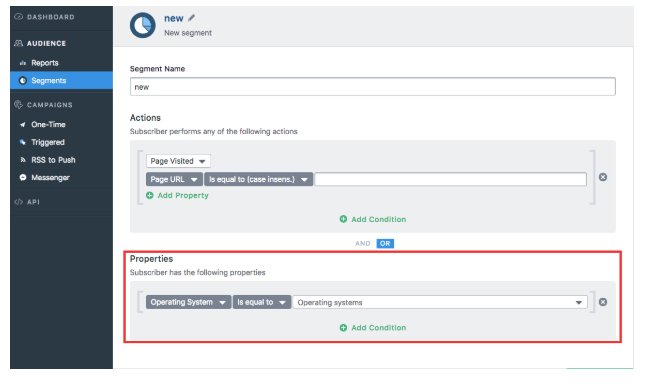
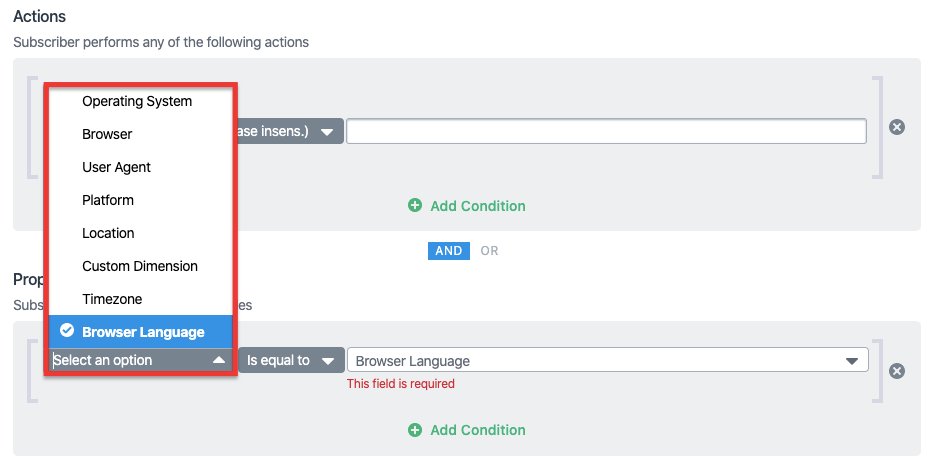
Segmentation based on page visits
Analyze visitors’ behavior on your website to gauge their intent. You may categorize them on the basis of the actions they have performed while visiting your site. You can create multiple types of segmentation based on the URLs your users are visiting.
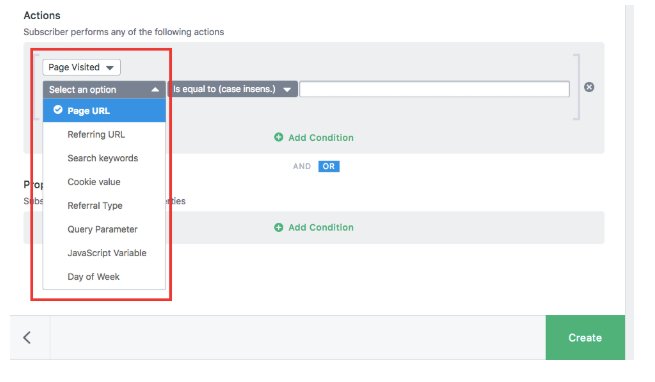
LA Tourism utilized VWO Engage’s segmentation feature and reduced their bounce rate by 43%. They created buckets based on the category of pages visited by the website users, which helped them understand their users’ interests to effectively send targeted web push notifications.
Segmentation based on click events
You can segment your users based on click elements to understand where your users are actually clicking. In this segment, you can create subscriber groups based on elements such as CTA buttons, text, images, videos, etc., clicked on by your user.
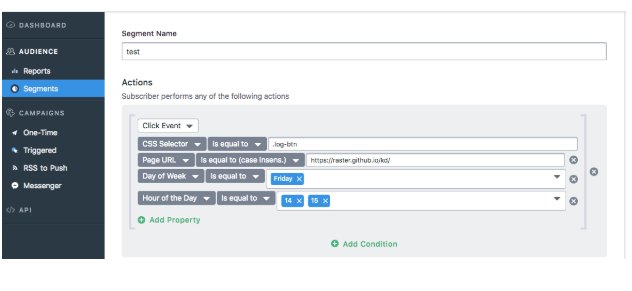
Segmentation based on geolocation
Geolocation segmentation makes your task easier by segmenting your audience based on specific countries, and even further by region. It’s easy to include or exclude any country or region, based on your business requirements. Start creating segments and trigger notifications according to your business time zone and region, just the way you want.
Segmentation based on JavaScript and API cookie
Functional and effective push notification tools like VWO give you the option of creating your own customized segmentation. With the help of a developing team, you can segment your subscribers based on the JS/ API variables in your code. Not just that, you can also manage it based on the Cookie key and value pair stored by your website on the user’s browser.
Impegio is a job hunting website based out in Italy. Primarily driven to generate leads and boost engagement on their website, they used VWO Engage’s audience segmentation feature, which resulted in 15% hike in their CTR. Start your 30-day free trial to make the best out of VWO Engage’s segmentation features and achieve skyrocketing conversions.
A/B test your web push notifications
With VWO Visual Editor, you can rigorously test your segmented push notifications campaign for conversions. You may optimize multiple elements, such as images, heading copy, emojis, etc to determine your users’ interests and devise further segmentation to pursue your conversion goal in a matter of a few clicks. A/B testing is an iterative process, so consistent experimentation can uplift the quality of your campaigns and also help you better your subsequent optimization efforts.
Conclusion
While generic push messages are akin to broadcasting media, segmentation brings a more focused approach to delivering a message relevant to a specific group based on their interest. This strategy for your marketing campaign lies in user behavior and personalization. In the era of hyper-personalization, make the best out of tools like push messages and invest in the smart way to get increased click rates and enhanced relationships with your customers.
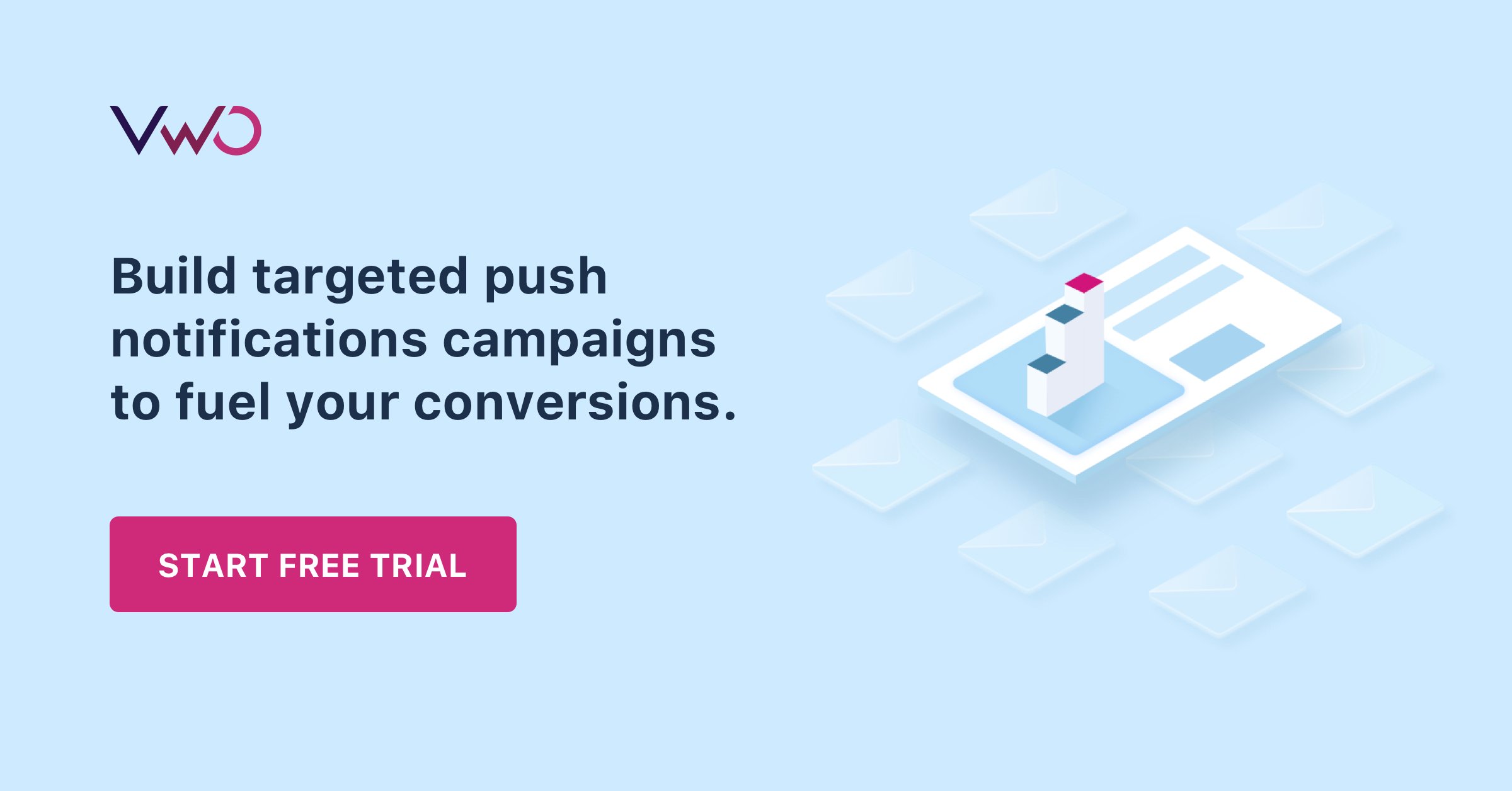
“People don’t like to watch ads!”
Such notions regarding ads come around often, leaving beginners in marketing freaked out for multiple reasons. However, the reality lies in data, which suggests that 47% of consumers are happy to sacrifice their privacy to get a better deal while shopping online.
Download Free: A/B Testing Guide

Yes. That’s right! This might surprise you, but consumers would not mind getting their behavior tracked in exchange for tangible benefits. For example, loyalty cards! So here is the good news for marketers—privacy is important, but if you’re abiding by the regulations, privacy concerns should not demotivate you from firing up a retargeting campaign to get your lost visitors back.
Warm audiences are a favorable lot for achieving conversions since they already have some previous experience with a brand. Let’s understand how this works.
What is retargeting and how is it different from remarketing?
Visitors who abandoned a shopping cart, browsed your site, or purchased an item from you are tagged with a retargeting cookie in their browsers. This enables marketers to use the cookie’s information to target these visitors with relevant ads based on their interactions once they leave your website.
Third-party platforms like Google Display Network or Facebook allow your ads to trigger on other sites that your visitors land on, thus helping you drive more leads and customers in your conversion funnel. This digital marketing tactic is known as retargeting.
When combined with A/B testing, your retargeting campaigns are more likely to perform better and drive conversions. For example, you can run A/B tests on your ad copy for CTA and form length, or design for different channels to evaluate the effective variation that brings you traffic and thus revenue.
Remarketing and retargeting are often synonymously used because they share similar, overlapping goals. Both strategies are focused on lead nurturing, building lasting brand awareness, and top-of-the-mind recognition, since it makes sense selling to people who have already shown some interest in the past over pitching it to somebody new. However, the two strategies are different.
While retargeting focuses on roping prospective customers into your sales funnel predominantly through advertisements (banner and social media ads), remarketing strategies remind users to re-engage through emails or push notifications.
Since platforms like Google Ads and Facebook have an added targeting capability that utilizes email customer lists, remarketing strategies such as email marketing to re-engage users and retargeting through ads can’t operate in silos. Instead, they work hand-in-hand as per your CRO roadmap to drive more leads and conversions, keeping a consistent message across channels.
Truth bomb: Retargeting doesn’t “creep” people out!
People might hate irrelevant ads because they are distracting, but that doesn’t mean they don’t notice relevant and targeted ads that subconsciously nudge them to buy the product they left in a cart. Email marketing and push notifications are a few remarketing tools to win back a prospective customer.
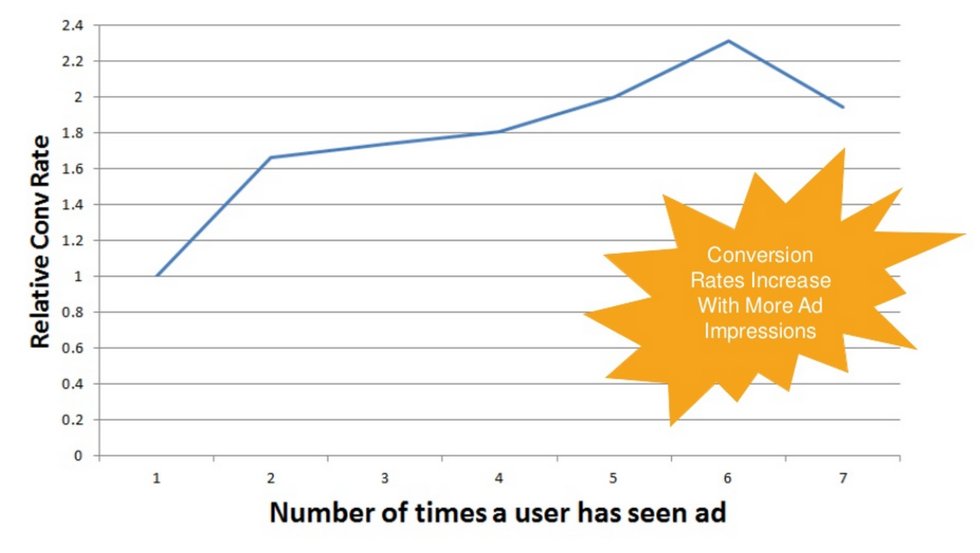
A case study suggested that using retargeted advertisements is a very powerful tactic in the complex B2B sales world to woo lost customers back. Postano, the company on which the case study is based, conducted an audit and assessed that Adwords and banner ads should be their retargeting focus.
They created banner ads in different sizes and variations tailored towards marketing directors and CMOs in different industries, such as, Sports, Fashion, Events, Ad agencies. They experimented to optimize these banner ads for relevant messaging and effectiveness.
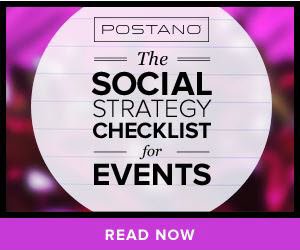
All the website visitors got cookied and went into the retargeting campaign for 60 days. They saw banner ads on the website as a part of Google display network.
On further testing, they dropped the non-performing ads and showed only the ones that brought them leads.
They concluded the campaign after the first 60 days of the retargeting effort and achieved a 364% increase in clickthrough conversions and a 278% increase in conversion rate (measured by requested product demos.)
Crucial retargeting concepts for CRO
Retargeting visitors, who have relatively higher intent to convert than the organic first-timers, to pull them back into your sales funnel is just half the job done. Conversion happens with sales.
SEO and retargeting practices can help you get relevant traffic in anticipation of conversion. That’s where CRO begins to play its role.
Best practices for retargeting success
To make the most out of your acquired traffic via ads, remarketing and SEO combined, CRO helps you address the apparently ‘not-so-glaring’ gaps methodically and optimize your conversions.
Observing your visitor behavior and hesitations
The first step in pursuit of maximizing your conversions is understanding your visitors—what actions are they taking on your website. Tools such as VWO insights’ heatmaps, session recordings, and funnel analysis enable you to observe what happens when a visitor lands on and leaves your page.
While behavior analysis tools can address your drop-off rates, you should also use on-page website surveys which are a powerful tool to understand your visitors’ hesitations and get first-hand qualitative feedback on why they abandon your website without taking a desired action.

Download Free: A/B Testing Guide
Deriving insights and planning
Heatmaps and session recordings help you gather data to derive crucial insights. Based on insights driven from these analyses, you can generate A/B testing ideas on your high-traffic landing pages. The best practice is to test the crucial elements on your page, such as:
- Messaging (headline, page copy, social proof)
- CTA and form length
- Design and page navigation
- Value proposition
For example, on the VWO website, we use sign-up numbers from the previous week on one of our landing pages as social proof. We also have a single-field form to reduce friction for visitors. Both of these were A/B tested using VWO before being deployed on the website.
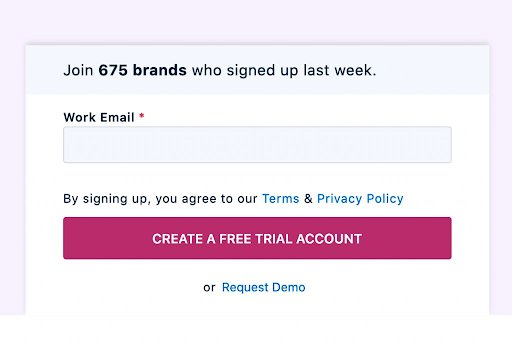
Experimenting to optimize conversions
Running A/B tests to optimize the conversions on your website elements scientifically approves or disproves your hypothesis, and helps you make decisions backed by data and not by instinct! However, don’t consider A/B testing as a one-time elixir shot to sustain your conversion game.
You ought to create a CRO roadmap for this continuous process, to observe, test, implement, and repeat the cycle, if you want consistent improvement in your conversion rates.
For example, you can segment your visitors in your marketing platforms like Google Ads to show ads and messages to visitors based on your funnel stage. Marketers can download and assign existing audience, where on the basis of the type of campaign you want to run, you can target audience under life events, interests, remarketing lists categories. Among all, Google Ads’ remarketing list for search ads (RLSA) feature enables you to create your search campaigns depending on if a visitor has visited your site and pages.
Google Ads allows you to run A/B tests and set up ad clusters for your campaigns. You can utilize them to optimize your ads and figure out how effective their performance is.
Retargeting in B2B space
Retargeting lays its origins in the eCommerce industry, but it has outgrown its confines to a multitude of industries, and B2B is no exception.
B2B sites are limited on the number of users as compared to eCommerce or other B2C spaces. A few tactics like ‘Omnipresent Marketing’ enables B2B companies by selectively targeting high-intent users by showing them Facebook ads, banner ads across channels and devices, wherever their visitors go. By constantly staying in the sight of potential customers via emails, and push notifications (if they have opted-in), the chances of their conversion soar.
Here are a few ways that can help you acquire potential leads and thus revenue:
- Use industry-targeting: Craft relevant and specific messages for different industries in your remarketing campaigns to bring back a lost customer. Figure out what pages your visitors surf and pitch in your ad. For example, you can resurrect your dormant subscribers who haven’t engaged with you in a while through email, wherein a relevant message that speaks their language can certainly steer them back into your sales funnel.
- Be mobile-first: More than half of the traffic on social media comes from mobile devices. Optimizing for mobile should be a priority/focus area for you. For example, you can target users on any device using paid social media to bring back a user who did check out your product and pages but did not convert.
- Use email addresses for remarketing campaigns: Run your retargeting ads not only for your website visitors but also to specific users. For example, Facebook custom audiences enable you to run Facebook ads based on the email addresses of the users. Also, you can identify the funnel stages of your specific visitors to craft a personalized copy for your ads.
- Segment your visitors in the funnel: Platforms like Google Ads allow you to show ads and messages to visitors based on the pages they have interacted with. You can estimate the funnel stage of your visitors using tools like funnel analysis that enable you to create advanced custom segments as per your needs.
VWO Engage as a remarketing tool
Among many popular retargeting tools, VWO Engage stands out. It enables you to keep your visitors engaged with automated marketing campaigns through web push notifications. Web push notification is a much faster tool as compared to emails to rope in that lost customer.
In addition to that, you can also bring back lost customers through a personalized cart abandonment campaign, enticing them with irresistible offers.
VWO Engage helped Ubisoft, a publisher and distributor in the gaming industry, to increase the number of returning visitors on their website using web push notifications which resulted in an average CTR of 17%. VWO helped them achieve what was double and even quintuple of what Ubisoft’s initial expectations were.
Conclusion
A cutting-edge technology, retargeting is underutilized and mostly misunderstood with the traditional acquisition of new customers. When done wisely, retargeting (or remarketing) enables marketers to build a holistic and sustainable CRO ecosystem that caters to lost visitors at every stage of the funnel.
Having retargeting as an integral strategy in your CRO plan would not only ensure steering your lost customers back but also allow you to optimize your marketing campaigns for better conversions. And that’s how you can make the best out of visitor traffic.
Sign up for a free trial of VWO Engage tool to win back your lost customer.
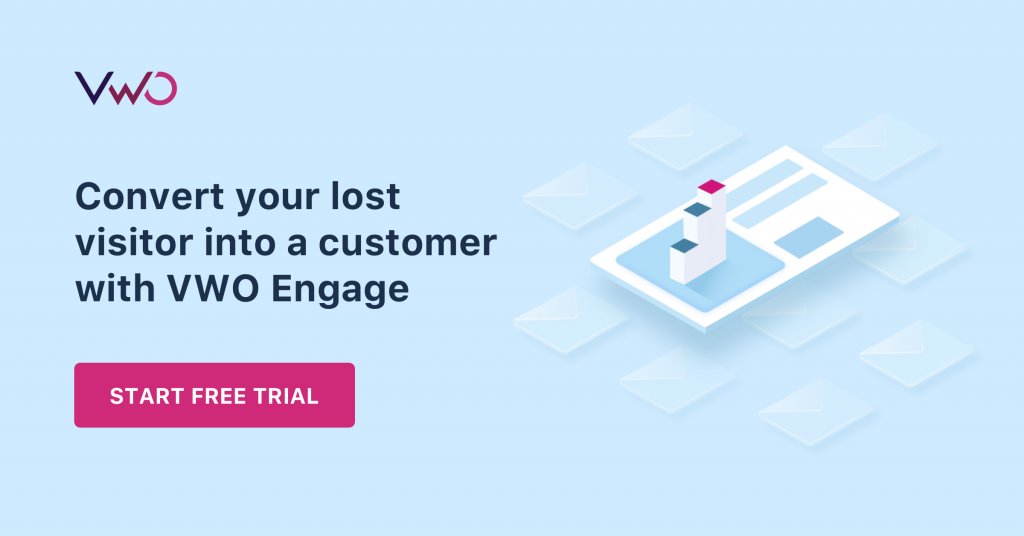
But, many companies, irrespective of their operational domains, still struggle to find smart and tactical ways to segment site visitors. As a result, the gap between what website visitors want and what they get (or what a business offers) is quite extensive.
Download Free: Visitor Behaviour Analysis Guide

In this blog post, we aim to shed some light on the whys and hows of visitor segmentation and its importance as one of the most critical conversion parameters.
Let’s begin!
What is Website Visitor Segmentation?
In the simplest of terms, website visitor segmentation is the process of segregating prospects and customers into different groups based on some fundamental parameters such as geography, visitor behavior or characteristics, acquisition sources, psychographics, and more. By using segmentation, you can not only provide your website visitors with more relevant and targeted content, product suggestions, and marketing messages but drive more sales and reap high business rewards as well.
How to Segment Website Visitors?
Segmentation is one of the key pillars of marketing. It’s a method to better understand your target audience, cater to their varied needs, and provide a much-enhanced visitor experience that gets more repeat visitors and purchases to the business.
There are several ways to segment your website visitors. For instance, as a SaaS company, you can segment your visitors basis the sales funnel stage they sit on, such as website visitors, pro-plan subscribers, blog subscribers, newsletter subscribers, social media platforms, and so on. As an eCommerce business, you can segment based on their geography, gender, shopping history, and more.
But ideally, it’s always good to place your website visitors into four primary segments. These are as follows:
1. Behavioral Segmentation
Though the most common in the lot, behavioral segmentation definitely tops the list. In addition to segmenting visitors on the basis of their behavior on your website, it helps you to identify the right patterns or content to engage your website visitors and ensure they leave satisfied and come back for more.
Amazon suggests products to its customers based on their shopping history as well as their real time actions on the site. Meanwhile, YouTube recommends videos based on a visitor’s viewing history. Facebook follows the same mechanism too. It shows posts based on a users’ likes and pages they follow.
One of the most significant advantages of using behavioral segmentation is that it’s typically based on well-documented visitor behavior which makes targeting both new and returning visitors easier. But, the offside to this is that it doesn’t take into consideration a targeted persona’s intent very accurately. For example, if a person buys a leather jacket from an eCommerce site, is it a good idea to suggest more leather jackets the next time they visit? Probably not!
2. Demographic Segmentation
In this arena, questions like, “What’s the age of your visitor?” “Are they male or female?” “Where do they live?,” etc. typically help to define the demographics of your inflowing traffic.
Also, such segmentation is most useful for businesses for whom physical and socio-economic factors matter the most. For instance, let’s consider a restaurant tech solution platform like Dineout. It needs to know a customer’s location to recommend the best restaurants near them. While an 18-year-old individual may be more interested in finding fast-food chains such as Domino’s or Burger King, someone aged 30 years may, alternatively, be most interested in a sushi restaurant or one that serves alcohol.
Similarly, an online sports store may be in a position to recommend better sports products if they know a visitor’s demographics. For example, if you’re a 25-year-old woman, you’re most likely to look for a sports bra or a bralette rather than a man looking for the same on the platform.
The real deal here is that demographic segmentation is simple. You can easily pull out supporting data as well. Tools like Facebook Ads, Google Adwords, and Google Analytics allow you to conveniently and accurately gather data and further target individuals using their demographic information. However, the flip side to this kind of segmentation is that it’s mostly based on broad assumptions and doesn’t take into consideration many important factors including gender fluidity. This is where much work is needed.
3. Psychographic Segmentation
Of the other methods, psychographic segmentation is the most complicated one, as it takes into consideration things like a person’s emotions, beliefs, opinions, likes and dislikes, and so on.
Let’s say, you’re a fintech company that provides multiple insurance options to a wide spectrum of people with varying needs and preferences. To cater to such a myriad variety of individuals, it’s necessary for you to create custom segments. These may typically include categories like people who work in a high-risk environment and want to invest in accidental insurance, people planning for the second innings of their life and would want to invest in a retirement plan, or those living in harsh terrains who would want to secure their houses against natural calamities. Other categories can be around the risk appetite of individuals when it comes to selecting an insurance, the investment product itself and so forth.
By segmenting your target audience on the basis of their desires, beliefs, and hopes, you can offer them more relevant products and/or services, and also create relevant marketing campaigns and content to make them convert into loyal customers.
Psychographic segmentation is also the kind that most marketers and professional content writers use to create compelling marketing messages, especially email campaigns, and bring potential customers aboard.
Apple, Netflix, and Nintendo are some hotshot businesses that extensively use this segmentation strategy.
4. Geographic Segmentation
This is comparatively the most popular segmentation method used by marketers across the globe. Geographic segmentation allows you to effectively target prospects and customers from particular countries, or according to the keywords they use to land on your website.
For instance, Amazon segments its website visitors based on their geographic traffic sources to show relevant products. It tracks your IP address to confirm the region you belong to and even displays a disclaimer message on its homepage, redirecting you to your region’s Amazon site for much convenience.
Check out the image below:
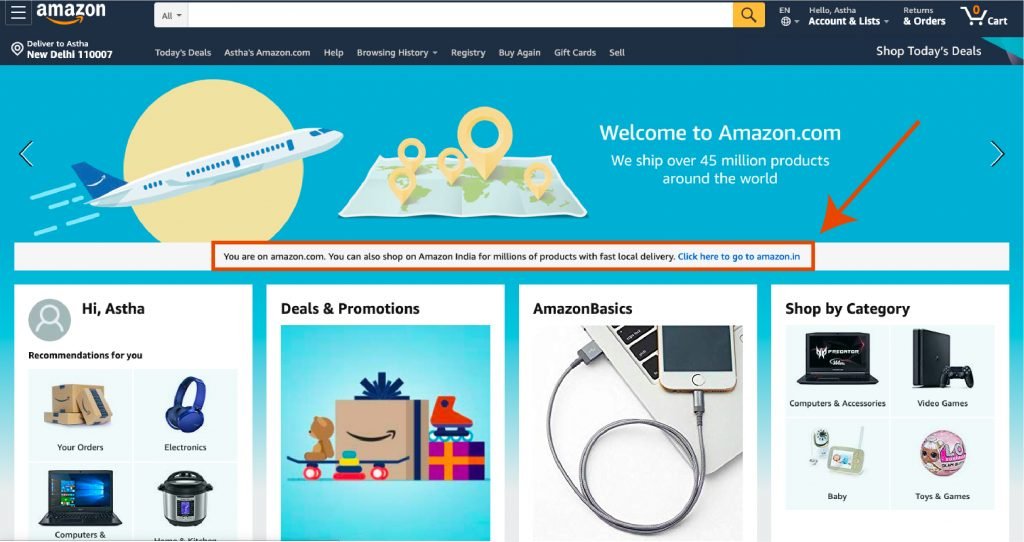
While each of the segments, as explained above, have their own value proposition, it’s always better to use the four in sync to create high-quality segments to not only add value to what you’re doing as a business but enhance your conversion rate as well.
What To Do After Segmenting Your Website Visitors?
Once you’ve created the right set of segments, it’s now time to use the gathered data to deliver a better and more enhanced website experience to your visitors by optimizing your site pages. How? Let’s dig a little deeper here!
1. The Homepage
Your homepage is the face of your business. It’s also the first page that your visitors interact and engage with. If there’s one thing that can make it better and appeal to the senses of your target audience, it’s segmentation. Here’s how you can use segmentation to your leverage and make your homepage your conversion magnet:
- By Demographics: Showing products and/or services geared towards a particular age group or locality, can help create buzz on your homepage and push more of both existing and first time visitors into your sales funnel. For instance, a company dealing in sports cars will target individuals aging between 20 and 40 years. On the other hand, a regional brand engaged in publishing women’s magazines would specifically target the female population of their respective country.
- By Behavior: Showing or recommending products to a visitor based on their on-site behavior and past browsing history on the homepage itself can prove to be significantly beneficial for your business. For instance, if a person has been searching for wallets and cuff-links, showing them as top results on your homepage alongside other recommendations such as ties and watches can considerably increase the chances of conversions.
- By Psychographics: While psychographic segmentation doesn’t really focus much on data, it demands rigorous research to unveil and understand what visitors actually want. For instance, the luxury car brand may choose to show a completely different fleet of cars to people who value quality and status than those with a different buying outlook. While, on the other hand, a B2B enterprise engaged in offering marketing services may create a homepage that specifically targets marketing managers who are looking forward to partnering with them for their respective firm’s marketing and promotional needs.
To be sure of your segmentation tactics, it’s always good to A/B test your ideas. Create multiple versions of your homepage for each targeted segment and run an A/B test to analyze which one performs the best.
Download Free: Visitor Behaviour Analysis Guide
2. Product Pages
When it comes to using segmentation for product pages, your go-to category should be behavioral segmentation. For the reason that it’s essential to understand your target audience’s actions or conducts to move ahead and pitch products that would most interest them.
To give you an example here. Let’s say the average LTV (lifetime value) of your online customer is $100 (i.e., your customer makes a purchase of $100 worth of products from your brand). And, say a customer who has already spent $400 comes back to your site. In such a case, it’s always better to first show those customer premium products in the categories they most browse through on your site, smartly followed by items with lesser value as add-ons. Further, adding filters such as ‘Price High to Low,’ ‘Price Low to High,’ ‘Popularity,’ and ‘Newest First’ can strategically help.
Meanwhile, let’s say another customer who has only bought handbags and related products. In such a case, show them your highest selling handbags like office bags, party clutches, totes, and wallets as the likeliness of them considering these options are maximum.
Organizing your products on product pages using behavioral segmentation will not only help you recommend better products to your target audience, but you’ll always stay in line with what your audience’s intent is.
3. The Landing Page
When creating compelling and engaging content for landing pages, bet your money on psychographic segmentation. For the reason that the data extracted from this segment not only helps you understand the psyche of your target audience (or readers, to say), but differentiates your brand in terms of language usability and overall presentation to increase engagement.
Quoting an example here, in addition to focusing on building brand content (by mapping trends and using tools like search engine optimization) for your landing pages, adding elements that directly relate to what a visitor wants can help get more conversions aboard. Intuit, a financial software company, uses demographic segmentation to show different landing pages to individuals coming from different regions and ensure to engage them in the most effective manner. It gathers data from a user’s IP and shows landing pages accordingly.
But, of course! A/B testing your ideas must always be a part of your plan to authenticate your learning.
What are Common Visitor Segmentation Mistakes To Avoid
Since visitor segmentation is quite complex, it’s obvious that mistakes will also happen along the path. So, being aware of them is paramount. Some common mistakes to avoid are as follows:
Over Segmentation: While segmentation has the prowess to offer highly specific information to your business to thrive, overdoing can prove to be equally troublesome. Because, when you segment website visitors at such granular levels, the process of dividing and combining turns intimidating. Successful visitor segmentation is only possible when done in the right manner and with the utmost focus. For it will not only help create the right number of segments needed for your business to target every visitor base but avoid confusions as well.
Segmentation Without Strategy: Visitor segmentation without a clearly defined strategy is like a pizza without toppings. So, it’s always better to have a plan in place to ensure all your data and resources are judiciously used. Understand that the very definitions of the visitor segmentation are what typically makes your entire marketing project/campaign effective, and this surely takes more than just the forethought.
Changing Segmentation Definitions: While the fundamentals of segmentation cannot be changed, the segments themselves can be altered, but only up to some extent. These can be primarily based on generation gaps, such as, what’s liked by Gen Z was not something appreciated by Gen Y, or psychographic, such as a shift in someone’s beliefs and so on. It’s critical to understand these ever-changing market dynamics and audit your visitor segmentations at regular intervals to maximize their effect.
Over Focus On Demographics: This is one of the most common mistakes made by marketers when segmenting their audience base. Overly focusing on demographics, at the expense of other segmentation categories, can lead to the wrong categorization, further costing your business in terms of lost customer acquisition opportunity. Rather, it’s essential to maintain a fair balance between all the categories and use the right permutations and combinations to avoid revenue spillage.
How to Use Visitor Segmentation Alongside Website Personalization?
Needless to say that personalization is the key to successful online marketing, and segmentation is a key component in making this possible. As per research by the Boston Consulting Group, it’s been established that marketers who use digital tools and meticulously articulated data for personalization purposes can increase their conversions and revenues by about 6% to 10%, which is 3x to its counterpart.
Visitor segmentation can help target the right people at the right time with the right message. Thus, making brand marketing more effective and efficient. Segmentation is not personalization. Rather, it’s the fuel that boosts the personalization engine enabling it to drive at a speed that’s unmatched yet much under control. Furthermore, visitor segmentation, when coupled with AI and machine learning, can help predict visitor behavior, influence their actions and decisions, and subsequently trigger messages that maximize conversions and revenue gains.
To conclude, visitor segmentation is useful in several ways. It’s a tried, tested, and trusted method that enables marketers to successfully run campaigns, understand market dynamics, even predict future trends, and get their A-game up and ready for all current and future challenges.
]]>If you’ve ever experienced the eerie sensation of being followed around online by an ad or a product, you’re neither wrong or alone.
Download Free: A/B Testing Guide
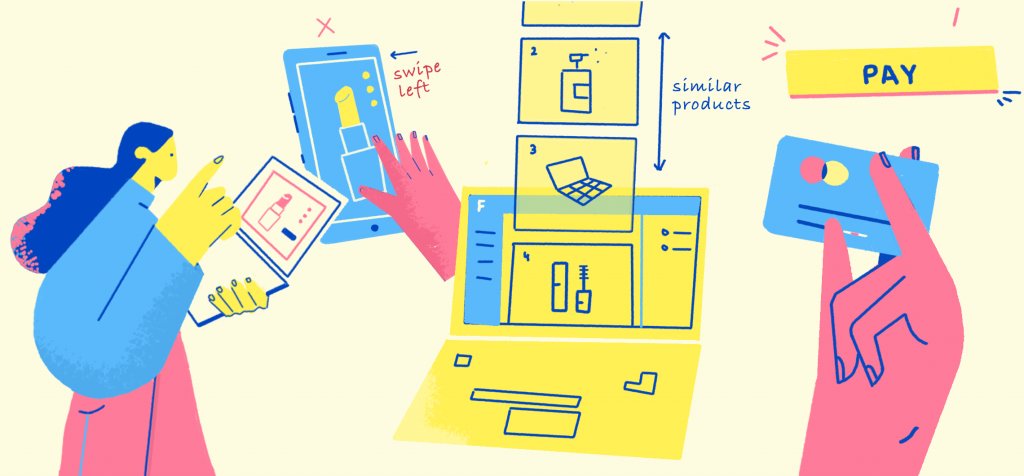
3 out 4 consumers report noticing retargeting ads online.
Indeed, retargeting is bigger than ever!
Retargeting tools are fast becoming an integral part of a marketer’s toolkit as well as a major aspect of marketing strategy.
What is “Retargeting”?
Retargeting, also known as remarketing, is a digital marketing tactic. While traditional digital marketing aims to bring new traffic to a website, retargeting aims to reach out and bring back past visitors. When marketers build retargeting campaigns, they deliver personalized ads to past visitors based on their characteristics, engagement or even specific on-site behavior. This creates a familiar flow – you visit a website and then see ads from that website elsewhere online.
Does Retargeting Work?
Indeed it does.
Many surveys and studies over the years have affirmed and reaffirmed its effectiveness.
According to Kenshoo, the click-through rate on retargeting ads is x10 higher than traditional display ads, while the conversion probability of a retargeting ad is 70% higher. Agency spending on retargeting is steadily increasing year by year. In a recent survey, 77% of the interviewed marketers report that retargeting campaigns outperform display campaigns.
Why does Retargeting Work?
Marketers spend vast resources on bringing quality traffic to their websites. But despite their best efforts, 98% of the visitors don’t purchase a thing in their initial visit – some of them are browsing, others are comparing prices, while some may be a poor match.
VWO conducted a fascinating eCommerce study in which 54% of the consumers reported they’d buy a product they abandoned in the cart if they received a coupon or special offer.
Retargeting opens the door to re-engaging with website visitors and cart abandoners, bringing them in further contact with the brand, and building the awareness and trust necessary for a visitor to become a customer.
How does Retargeting work?
It all starts with a ‘Pixel’.
A pixel is a snippet of code installed on the website which tracks and transmits data on how visitors engage with the website back to the ad platform. It’s quite simple to install, and all the major ad platforms including Facebook, Google Adwords, Twitter, LinkedIn, Taboola, Outbrain, and others have one.
With a pixel installed, it is possible to build custom audiences from various visitors segments, based on their defining characteristics, on-site behavior, and interactions with the website. Once the audiences are built, a marketer can deliver targeted and personalized ads to them at any desired frequency.
Examples of Retargeting
As a marketing tactic, retargeting’s origins lay in eCommerce, and while it’s still very effective in that scenario, it has long since outgrown its confines and is now prevalent across the board in every industry and vertical. Here are a few examples of how retargeting is being used.
eCommerce – Dynamic Product Ads
A common retargeting tactic in eCommerce is dynamic product ads. These specialized ads feature products, similar or complementary, to a previously viewed or purchased product, effectively encouraging visitors to increase their purchase size, or purchase a product they were browsing. Wouldn’t you buy a case for that newly purchased mobile phone?
B2B Marketing – Cross-platform Awareness
In B2B marketing, tactics like ‘Omnipresent Marketing’ follow visitors across multiple networks delivering Facebook ads in the Feed, Google Display Network and search engine ads, and other platforms, in an attempt to stay in view of potential high value leads. By delivering articles, reviews and other 3rd party updates, the marketer attempts to constantly stay in sight of their potential customers, making their brand appear far bigger than they actually are to a select audience.
Lookalike Audiences and Acquisition
Lookalike audiences are a very powerful addition to a marketer’s toolset. Contrary to regular retargeting, which aims to retrieve past visitors, Lookalike Audiences generates new traffic which helps feed the top of the funnel.
The way they do this is by allowing marketers to take a group of users, commonly referred to as a ‘seed’, and ‘ask’ an ad platform to build another group of users that are similar to the origin group.
The resulting ‘Lookalike’ audience is essentially an acquisition audience, meaning, an audience that has yet to visit your website, but one that is highly likely to seriously outperform interest-based audiences. Lookalike audiences are used in eCommerce and across the board in every field.
Behavioral Retargeting
eCommerce marketers regularly target users who they believe have a high intent of purchasing. Usually, they focus on explicit intent for example, users who abandoned the cart. Marketers have an easy read on their intent and regularly target them to try and get them to complete their purchase.
The setup is fairly simple – the marketer creates an audience based on a clear cut action, in this case, the ‘add to cart’ button and targets it with dynamic product ads, coupons may be offered, a sense of immediacy is hopefully created and in 3-7% of the times the purchase will be made.
Unfortunately, in 2019, the average ‘add to cart’ rate in the US was only 4.19%.
For advanced marketers, explicit actions like add to cart aren’t enough, and they look deeper into interactions to find intent from actions that are less explicit and more implicit from logical analysis users’ behavior. For example, a user who spent 5 minutes on a blog post page and scrolled all the way down is likely to have read the blog post. One individual metric isn’t enough here, but their combination hints at the implicit intent of the user.
On this premise, advanced marketers build elaborate measuring systems using tools like Google Tag Manager to monitor user clicks, scrolls, and other metrics, using rules and logic to translate behavioral metrics into actionable intent indicators. Some marketers choose to automate the process with an external tool, preferring to focus on other aspects of marketing, like creative and content, leaving the measuring and heavy lifting to an external service.
Download Free: A/B Testing Guide
Best Retargeting Platforms
Retargeting is currently available on a variety of Ad platforms. The platforms in many ways are different and complementary, each useful for different goals. For this reason, marketers often use multiple pixels on their website. We’ll cover the major three in the following sections.
Facebook Retargeting
Facebook and its subsidiary Instagram, feature detailed profiles on over 2.4bn people. They are amazing at creating interest and demographic-based audiences as well as highly effective Lookalikes at scale.
You can add custom events visually, making their platform perfect for the eCommerce industry.
LinkedIn Retargeting
LinkedIn features the distinction of being a professionally-oriented social media network. Because of this, their quality of leads in unparalleled, making them perfect for B2B applications.
Google Remarketing
Google’s remarketing spans Search, Youtube, and the Google Display Network. It is so vast that it’s estimated to reach over 90% of the internet, making it an incredibly powerful platform and perfect for brand awareness across the web.
A few honorable mentions for this list are Snapchat, which features a younger demographic, making it attractive to marketers aiming for a Gen-Z audience segment, as well as Taboola and Outbrain retargeting that are very useful for content marketers.
Best Retargeting Tools
While it is possible for a marketer to work directly with the many ad platforms available, learning the interfaces and peculiarities of each platform is time-consuming and can be challenging. To simplify ad creation, management, and analytics, many marketers turn to 3rd party tools that sit between them and the ad platforms.
Here is a list of the best retargeting tools out there:
Retargeter
Retargeter is a well-rounded suite of products for marketers, with solutions covering a wide range of topics, from Dynamic Creative Optimization, which optimizes in real-time which ad to show to which user, to Advanced Audience segmentation. With Retargeter, marketers can track metrics like scroll depth, page view, and others, then combine them to create specific segments that marketers can target.
AdRoll
AdRoll has been in the market since the mid 2000s and is one of the biggest companies in their field today. Tens of thousands of marketers use their services for customer segmentation and retargeting. Theirs is a full-stack remarketing solution that may take time to adjust to, but the insights and reports it delivers are difficult to recreate on competing platforms.
Criteo
Criteo is a noteworthy competitor to AdRoll and a very well rounded solution. Though complex in terms of initial setup, they cover the full spectrum of creative, retargeting, automated bidding, and campaign operation, offering a cost per click pricing model, which appeals to performance-driven marketers.
SmarterHQ
Smarter HQ is a behavioral segmentation solution. Using Smarter HQ, businesses can optimize the way their ads interact with their customers. Using Smarter HQ’s in-depth user behavior analysis, a marketer can act on audiences across channels and platforms, creating meaningful engagement in real-time and at scale.
Fixel
Fixel simplifies engagement based retargeting, by turning the various interactions a user makes with a website into a single, actionable metric. In doing so, Fixel allows marketers to target their most engaged audiences without the need to build complex logic based on individual clicks or page views. Fixel then delivers the engagement metric directly into the various advertising platforms, building on existing workflows.
Perfect Audience
Perfect Audience is a great tool to persuade your lost visitors through a multi-channel approach. The tool offers seamless retargeting, which is carried out through the web, mobile, Facebook, Twitter, and more.
Perfect Audience’s integration with Hubspot allows you to align your retargeting campaigns with your Hubspot activities. By scanning through your landing pages and smart lists on Hubspot, Perfect Audience builds a relevant user-list for you to retarget. The tool provides easy segmentation of visitors based on various user-behavior rules.
Best Practices for Retargeting
When done right, retargeting builds on the natural flow and journey of customers, touching base when needed, and presenting the right product at the right time.
When done wrong, it is a down-right nuisance that can kill sales.
Here are a few points to keep in mind before you jump into building retargeting campaigns:
Choose the Right Platform and Placement:
Different platforms cater to different people in different settings. Choosing the right platform and taking users’ encounters with the ad into consideration can do a lot to improve campaign performance.
Understand User Intent:
The position of a user in a sales funnel or cycle, can not be understated and is important to take into account. Otherwise, you risk pushing too hard or not hard enough on a potential lead or customer. Even breaking it down to the basic top of the funnel or bottom of the funnel segments will make a world of difference.
Don’t oversaturate your Ads:
Unless it’s part of a deliberate tactic like this Vodka campaign, set a reasonable frequency limit to your retargeting campaign. Failing to do so both annoys your potential customers and wastes your budget.
Exclude converted users from your campaigns:
We can not stress this enough – don’t advertise products to users who have already bought the product you’re advertising. This common error is very simple to avoid, simply make sure to exclude users who have already converted from your campaigns. Failing to do so wastes your media budget and is a huge ‘turn-off’ for your potential customers.
A/B test your ad copy and visual:
Your ad copy and visual are the heart of your ad, and it’s very difficult to know which will resonate with your particular audience.
A/B testing them, the pricing, as well as value propositions is a very good idea.
Conclusion
Retargeting has been on the receiving end of some bad publicity. It can and should be customer-centric, delivering that often missing personal touch to digital marketing. Retargeting can take the customer into account – matching, expanding, and enhancing their online experience thereby converting customers better.
When deployed this way, retargeting solutions can help build on the natural flow and journey of customers. It would touch base when needed, present the right product or opportunity, at the right time – to the right people, which ultimately delivers performance for marketers and, more importantly, a better online experience for users.
]]>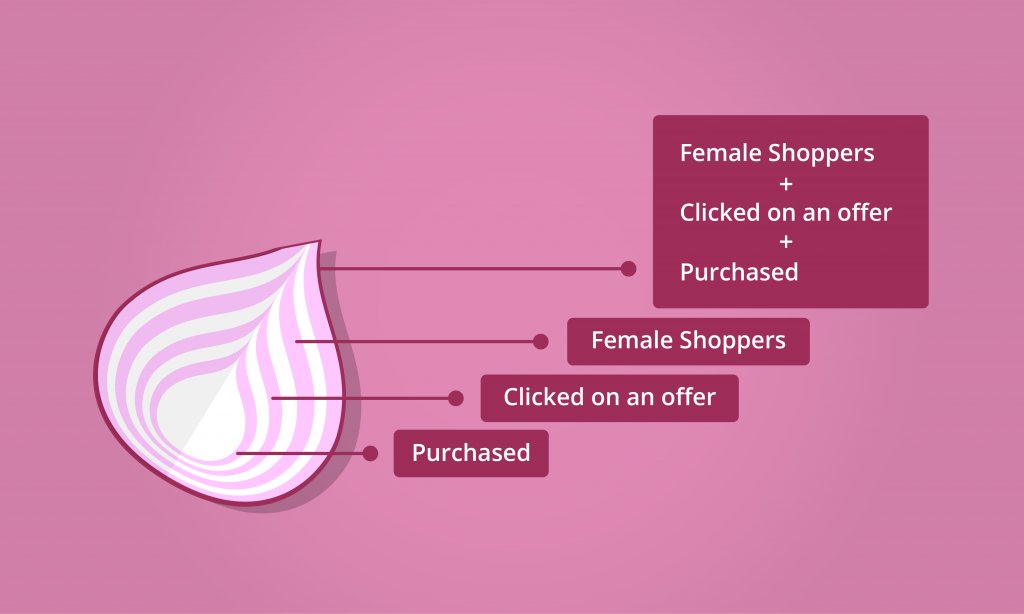
Whether the chef ends up leading operations at a corner tuck-shop or makes her way into a Michelin-rated restaurant is a function of how she goes about unpeeling the various layers. Successful marketers realize that competitive advantage rests in identifying high-value micro-segments for keeping in step with their customers to unearth fascinating insights from their journey.
Download Free: Visitor Behaviour Analysis Guide
What is a micro-segment, you might ask?
A micro-segment is nothing but a composite of multiple sub-segments that come together to form a bigger segment. Such segments are typically more granular and allow marketers to look at buyer behavior from multiple lenses. A good example of a micro-segment would be
“Visitors from organic search (Segment 1) who landed on our shoes page (Segment 2), clicked on an offer banner (Segment 3) and purchased (Segment 4) through an iPhone (Segment 5)”
Through “Bracketed Segments,” VWO is empowering e-commerce leaders to observe micro-segments at the click of a button to introduce unparalleled powers in a marketer’s arsenal across user research, tracking & analysis finally culminating in testing. By means of 3 examples, this article intends to showcase the many ways in which marketing teams are exploiting Bracketed Segmentation through VWO.
So, without further ado, let’s dive in!
***
Understanding behavior of “iPhone users” who “purchased” from a “country/city”
That iOS users boast of a greater purchasing power[1] is an obvious assertion – what is not obvious though is visualizing their behavior from additional behavioral & demo-graphical standpoints.
By deploying bracketed segments in VWO, eCommerce marketing teams can filter users with buying intent (users who visited “cart” or “checkout” pages). Most don’t stop there – city-level drill down is an additional lever of interest.
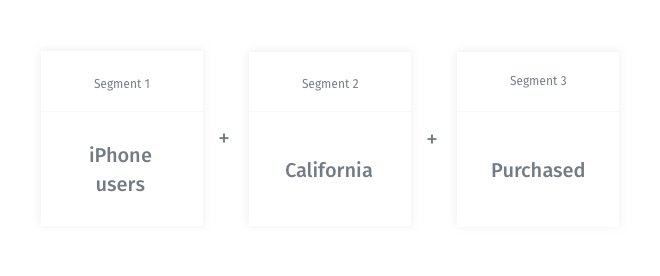
The following is a representation of how users can analyze session recordings of “iPhone users” who”purchased” and are “from California.” Think of this problem statement as a composite segment that combines three individual segments
Segment 1: “iPhone Users“

Segment 2: “Purchased“
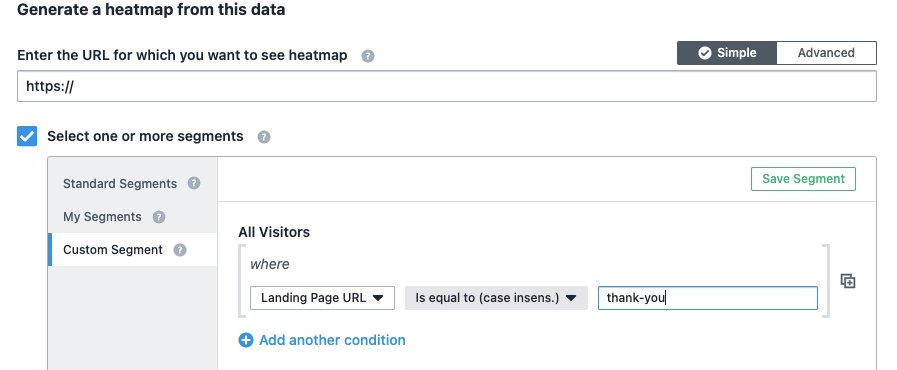
Segment 3: “From California“

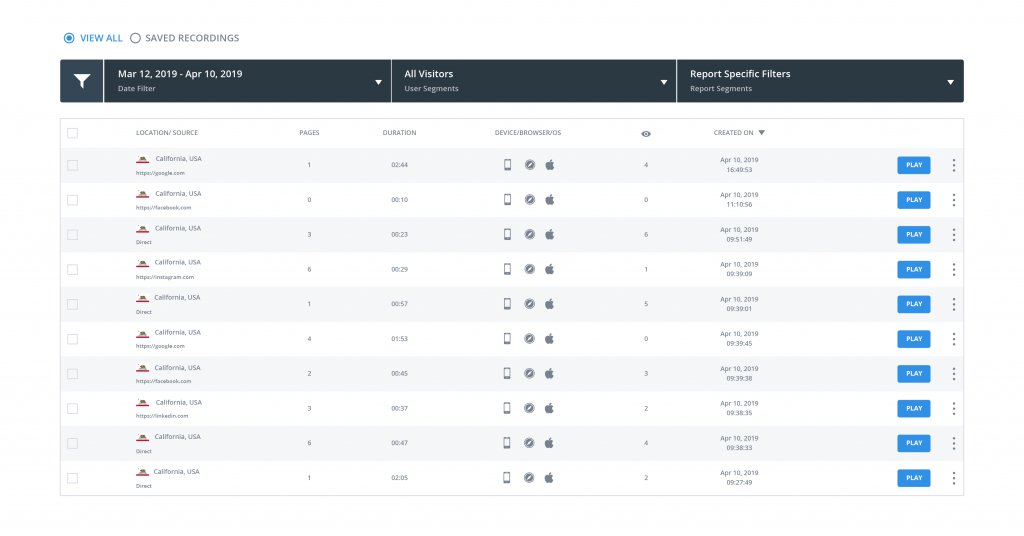
of “iPhone users” who”purchased” and are “from California.”
***
Comparing Heatmaps of “VIP Shoppers” vs. “Regular Visitors” from “United Kingdom”
Another area of interest for eCommerce marketing teams is comparing heatmaps of two or more segments together, for example, “VIP Shoppers” versus “Regular Visitors” – after all, stand-alone heatmaps are irrelevant unless used for comparisons. Such comparisons helps you to answer questions like
- Which areas of the website’s real estate are more interesting for VIP Shoppers?
- What are some specific buttons/links that appeal more to VIP Shoppers?
Using VWO’s Custom Dimensions, marketers can tag a visitor as VIP (or Regular). The platform can be used to classify a dimension in one of the two scopes—session and visitor—which allows for the desired breadth marketing that teams seek.
Note: “VIP” and “Regular” tags are fed into VWO by integrating with an eCommerce CRM of your choice[2].
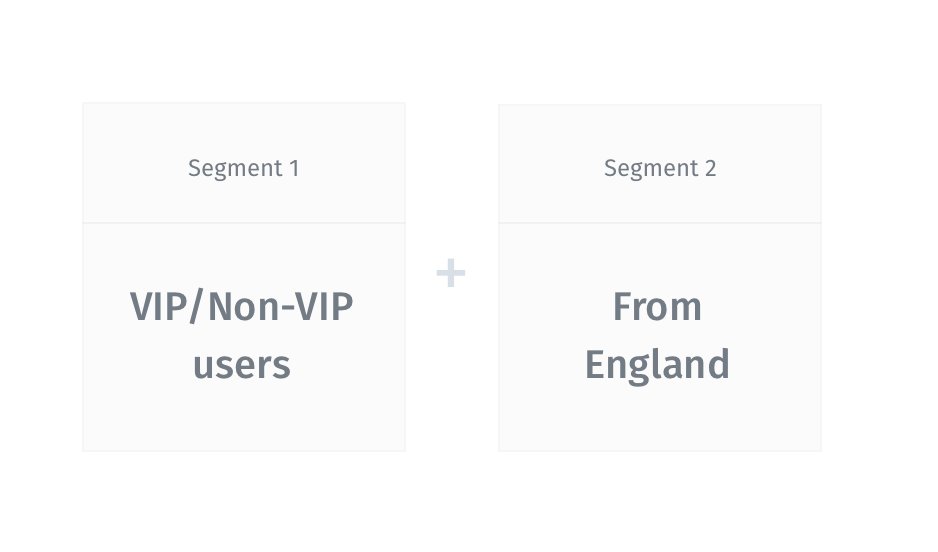
Tagging a visitor as a VIP or as a Regular entails a “Visitor”-level classification, which can be triggered from the platform as shown below:
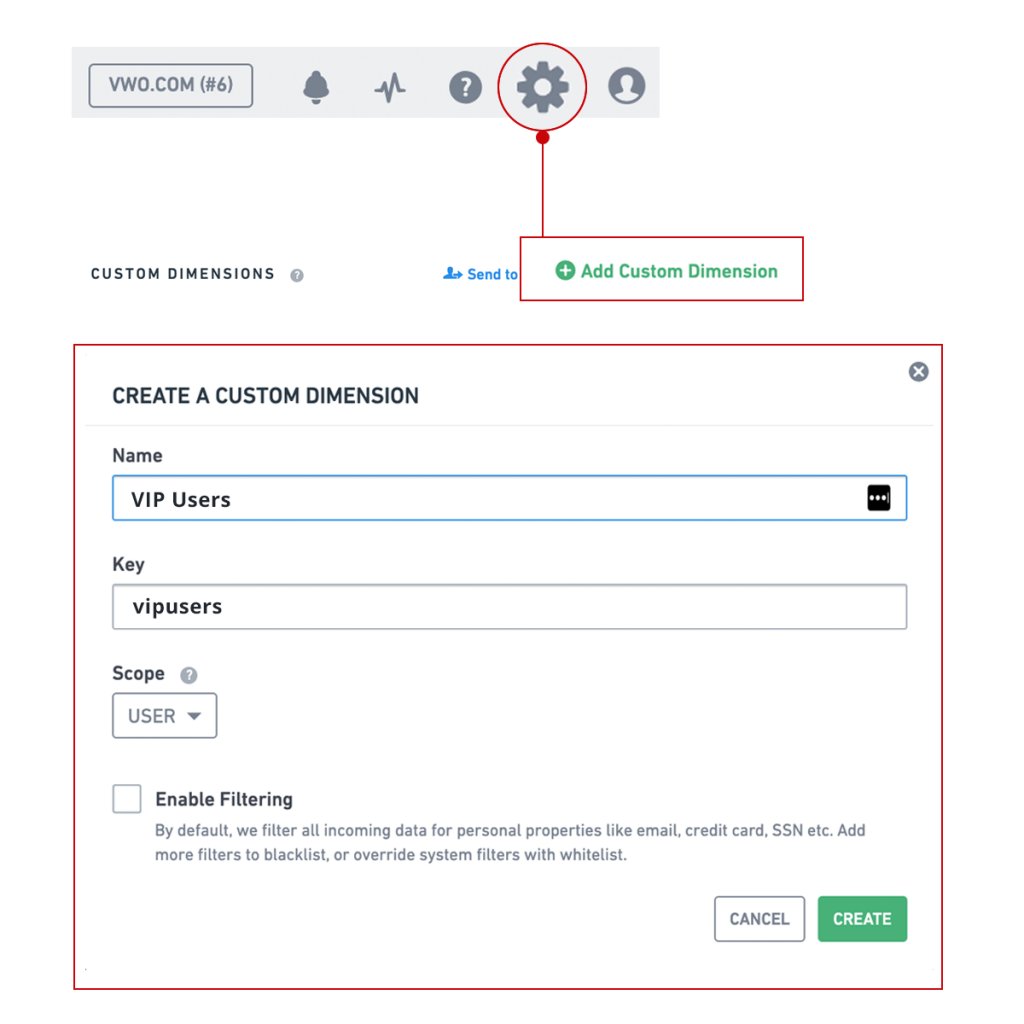
After creating a user-level scope and terming the dimension as “Buyer Type” the next step for the users is to configure the following code snippet on the ecommerce store’s pages. For the uninitiated, “Buyer Type” is the name of the broad segment which is represented by the key “user_type_by_value“.
In our example below, the assumption is that the variable “crm.visitortype” returns “vip buyers” in case you have tagged the visitor as one. In case the visitor isn’t tagged, they are classified as “regular buyers”
(Note: If you are unsure of which variable holds the desired VIP vs Regular value, please reach out to your developers or forward them the link to this article)
window.VWO = window.VWO || [];
// Replace TAG_VALUE with your actual tag value
window.VWO.push(['tag','user_type_by_value', crm.visitortype,'user'])In the above code snippet, “user_type_by_value” is representative of the type of visitor that users would want to segment. As stated earlier, “crm.visitortype” generates the desired micro-segment – VIP or Regular.
And voila! VWO will now start classifying visitors as VIP or Regular.
To access clickmaps of the 2 segments:
- Click on “Select one or more segments” when you click upon heatmaps
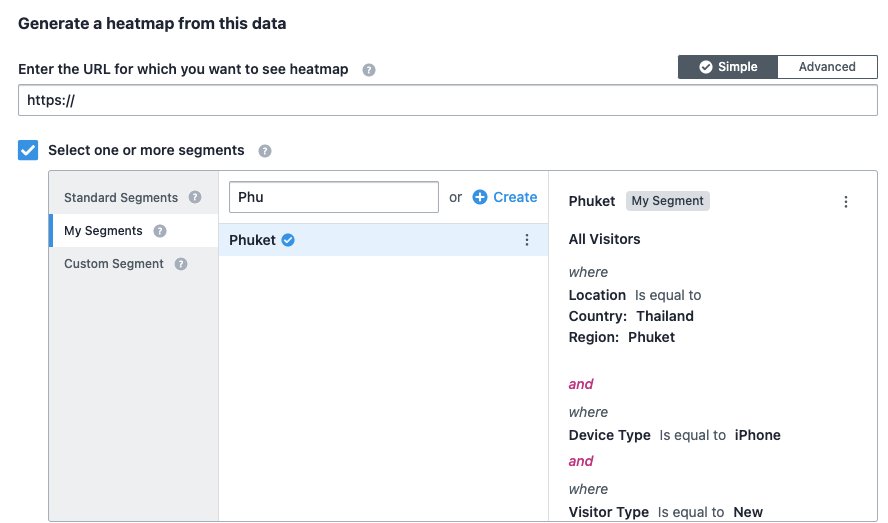
- Search for Custom Dimensions – a drop-down option reveals the option. “Buyer Type” should be the chosen tag along with “vip buyer” and/or “regular buyer” as the accompanying value.

To access a view of buyers from the UK, search for “Location” from Custom Dimensions, and then select “United Kingdom” as the country of choice.
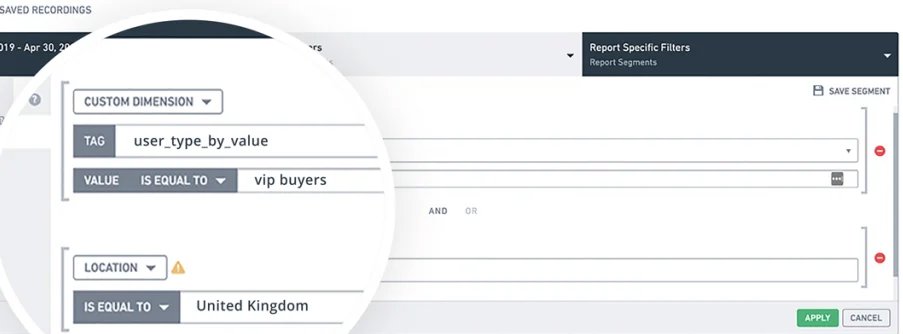
To check out heatmaps for non-VIP buyers just replace tag value with “Regular Buyer” and repeat the process.

Most marketers proceed to analyze the two heatmaps by looking at them side-by-side. Here is how heatmaps looked like, for the two segments, for a VWO customer – Clearly, what’s hot for one segment is not for another!
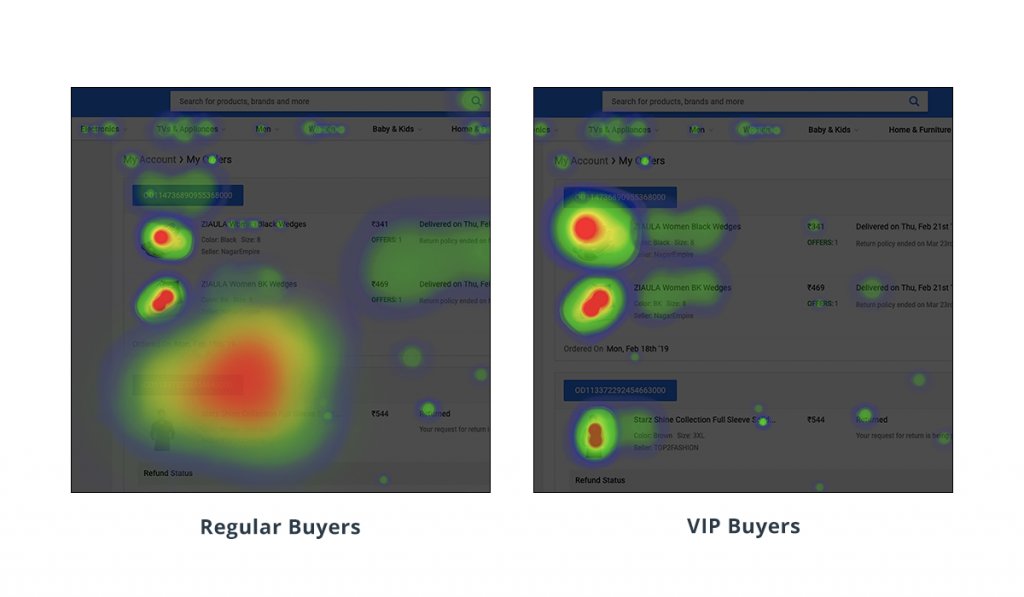
***
Download Free: Visitor Behaviour Analysis Guide
Breaking down “female users” who “clicked an offer banner” and “purchased” – aka Bargain Hunters
You can’t possibly document an e-cCommerce pooled-segmentation story without introducing the “offers” tangent. A 24/7/365 deals or flash sales environment across the entire spectrum of eCommerce has led to marketers carving a specialty segment—bargain hunters[3].
Bracketed segmentation allows marketers to split the broad bargain hunter into multiple micro-segments. Some prominent micro-segments are
- Bargain hunters from a city/country
- Bargain hunters by gender (male/female)
- Bargain hunters by source (direct/organic/search)
In this example, let’s dive into the following problem statement
How do I analyze the behavior of “female shoppers” (segment 1) who “clicked an offer” (segment 2) and concluded the session with a “purchase” (segment 3)?
Let us now break down the above statement into its individual components:
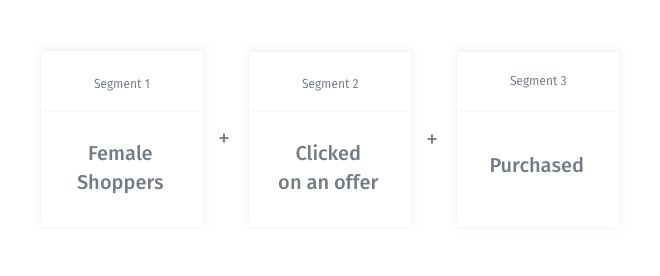
Slicing visitors who clicked an offer
A pertinent question that our clients often ask us is, “How do I identify my bargain hunters?”
Most offers are preceded by a site-wide banner advertisement that leads visitors to the offers page. For a typical e-tailer, Bargain Hunters would be all visitors who click the advertisement to proceed to the offer page. To collect data of all such sessions, all you need to do is to configure a simple <onclick> function that gets relayed to VWO through the following code snippet
$('.offerbannerad').on('click', function()
{window.VWO = window.VWO ||
[]; window.VWO.push(['tag',
'offerbannneradclicks', ‘endofseasonsalebanner',
'session']); });In the above snippet:
‘offerbannerad’ = Function that assembles all sessions in which banner ads were clicked
‘session’ = As “clicks on banner ad” falls under a session-wide scope
VWO users can filter all sessions with clicks on the offer banner by following the steps outlined below.
Note: The following steps denote analyzing session recordings. Users also have the ability to analyze clickmaps, heatmaps, surveys, form behavior, and A/B test reports for the same segment.
- Click Recordings in the left panel of the platform.
- Then click the All Visitors tab – it displays a larger window with Custom Segments. Clicking Custom reveals a drop-down – search for “Custom Dimensions” in the drop-down options.
- In the Tag field, search for Offer Banner Ad. Type the first few characters, and then click the correct string from the displayed options. Click the string to secure your tag.
Value of the tag would be “endofseasonsalebanner.”

- Click Apply to reveal all sessions in which the banner was clicked.
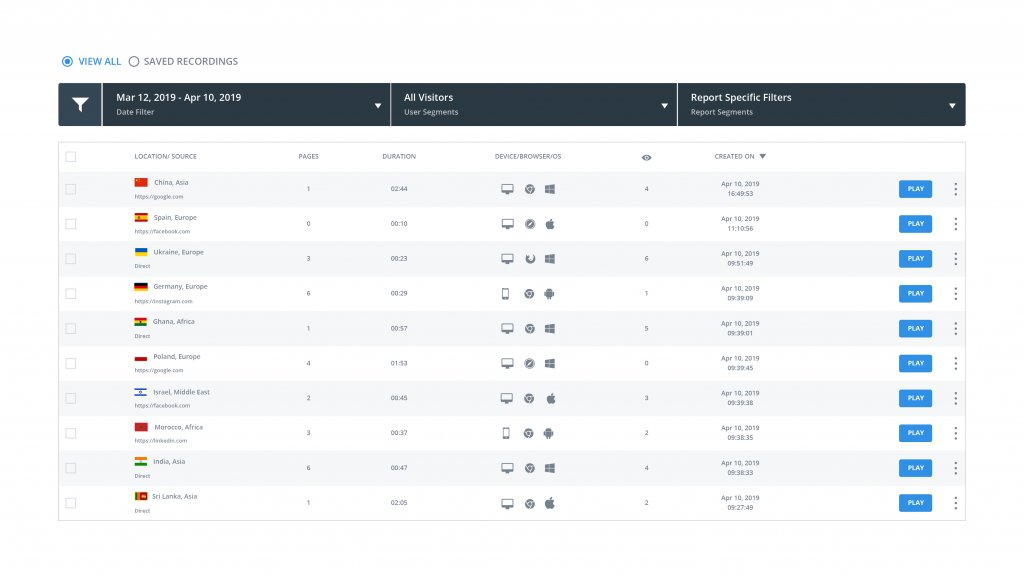
Slicing “female users”
Remember the ‘Buyer Type’ example from above? Like how ‘VIP vs Regular’ is a trait defined by the user’s purchase quantum (a function of loyalty), ‘male vs female’ is also a user trait that differentiates the two; therefore, the scope defined for this segment should be user.
The code snippet to introduce a ‘female’ slice as a segment is like the one we used to identify a VIP shopper – the only difference is the “tag” nomenclature.
<br>window.VWO = window.VWO || [];<br>// Replace TAG_VALUE with your actual tag value<br>window.VWO.push(['tag', 'user_type_by_gender', ‘females’, 'user']);<br> window.VWO = window.VWO || []; //
Replace TAG_VALUE with your actual tag value
window.VWO.push
(['tag', 'user_type_by_gender', ‘females’, 'user']); user_type_by_gender = Broad filter that classifies users per their gender
females = All female users
(Note: Classification by gender might be driven by data flowing from eCommerce CRMs.)
To access all sessions of female users, just search for “females” tag through the custom dimension “user type by gender”

Slicing Purchase Sessions
A comparatively easier segment to slice, to access all sessions that concluded with a purchase look for ‘Landing Page.” Assuming your e-store has a “Thank You” page signaling a purchase, all you need to do is
- Search for the segment “Landing Page URL” in Custom Dimensions
- In the drop-down below, select contains
- Type “thank-you” in the box next to “contains” and click apply
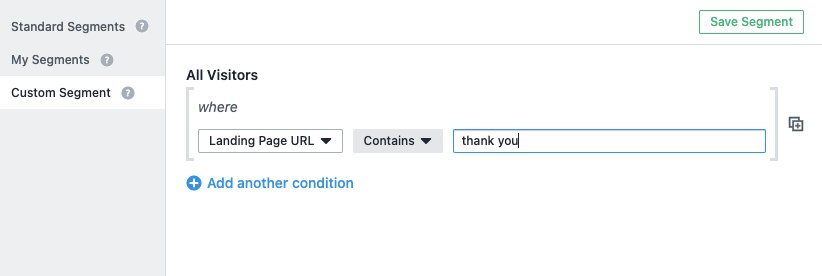
To exploit the power of bracketed segmentation, just add the 3 segments together and the user will have access to detailed session recordings of “women” who “clicked the offer” and “purchased.”
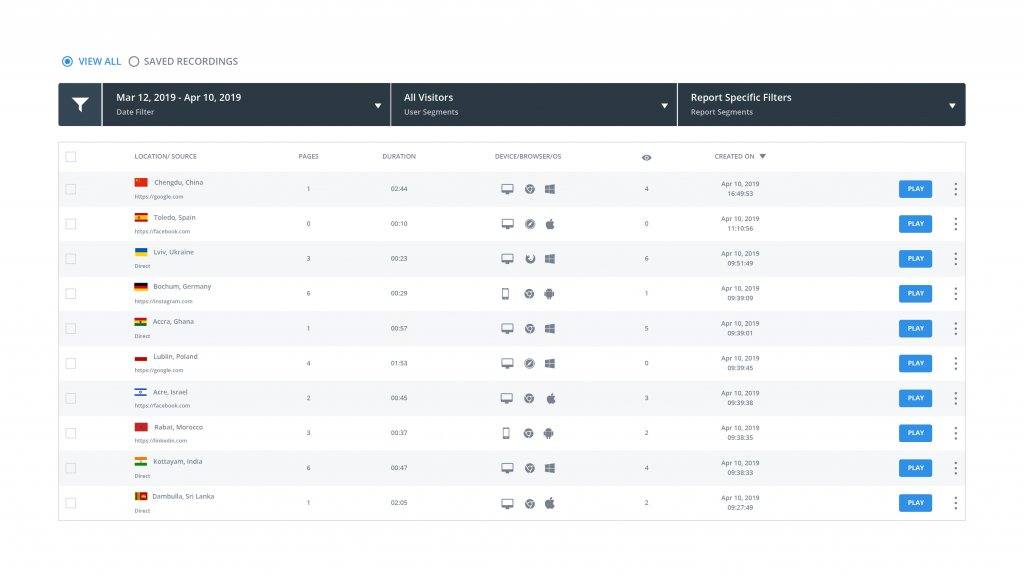
***
Bracketed segmentation is a powerful tool in an eCommerce marketer’s arsenal. Your powers are only limited to your imagination—to further it, following are some lucrative segments for your business that you can start analyzing today.
- ‘Used a specific payment method’ AND ‘are from a particular city’
- ‘Males’ who ‘browsed a particular category page’ AND ‘added to cart’ BUT ‘did not purchase’
- ‘Females’ FROM ‘a particular country’ WITH ‘an LTV greater than the average’
What are some of your preferred segments? Let’s start a chat in the comments?
]]>“You are not special. You’re not a beautiful and unique snowflake. You’re the same decaying organic matter as everything else.” – Chuck Palahniuk, Fight Club
While these words may hold true when we look at humanity from afar, it isn’t the best mantra to follow while sending out customer communications. Put your push notification subscribers under a microscope, figuratively, and you’ll see that not all of them stick to a monolithic persona.
Download Free: Push Notifications Guide
However, it’s an uphill task to examine each one of them individually, and this is where Audience Segmentation steps in.
What does Audience Segmentation really mean?
You may have anywhere between a hundred to several thousand push notification subscribers. To add to that, your subscriber list is subject to the laws of nature, like growth and churn.
Audience Segmentation automates the process of making sense of your ever-changing and diverse audience. You don’t have to manually sift through your list of push notification subscribers to understand their demographic data, actions, or user journeys. If your push notification service has a Segment Creator, like VWO Engage does, it does the job for you. Furthermore, it’ll help identify patterns and group your subscribers into different buckets or segments that you can use to define your audience, while sending notifications.
You can segment your users based on their,
1) Properties like location, device, browser type etc.
2) Actions performed like pages visited, referring URL, etc.
Here’s an example of how you can create a segment using a combination of both. The segment under scrutiny here comprises your audience from India who visited your Cricket Live Score page.
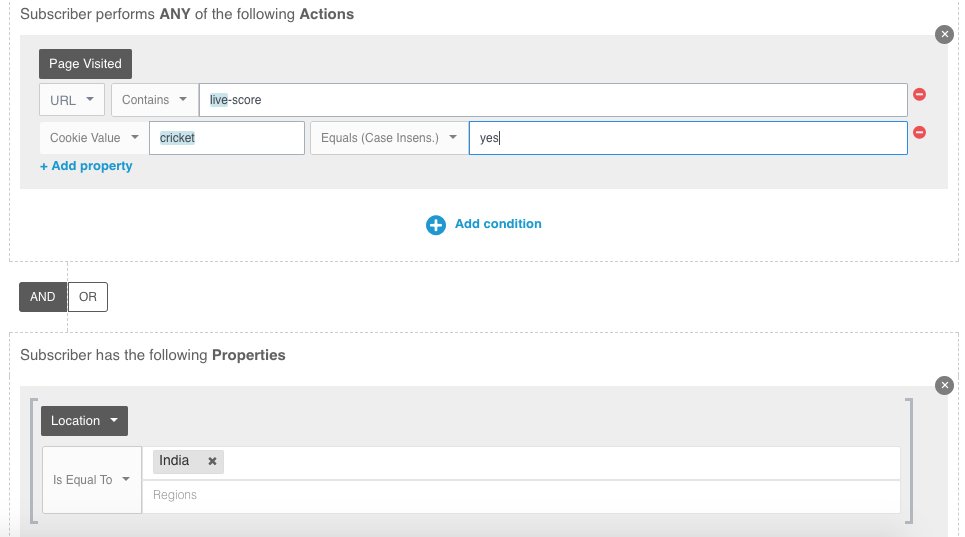
Why you should segment your subscribers
At this point you may ask why it’s necessary to make sense of all this data. Here are a few reasons why you should.
1) The problem with ‘Spray and Pray’
There’s a rationale behind why we say that push notification marketing can be grouped under TTL (Through the Line) marketing. TTL marketing channels blend the best of conventional marketing methods (ATL or Above the Line Marketing) as well as the more focused or niche marketing channels (BTL or Below the Line Marketing).
Let me elaborate on this. On one hand, push notifications have the power of reaching a large audience, just like television or radio. On the other hand, it possesses the capability of talking to a focused group within this large audience or even performing one-to-one communication, like Direct Marketing.
When we do not segment our audience, we harness only half of what push notifications are capable of.
The only upside of this approach, wherein you send the same notification to everyone on your list, is that:
– More subscribers will receive your notifications.
However, on the downside,
– Everyone who receives the notification will not click on it as it’s not relevant to them. Your click rate will go down.
– Readers may unsubscribe because you’re spamming them with updates they are not interested in.
– Your return traffic will decrease as your number of subscribers go down.
These are the reasons why broadcasting your notifications can be considered as a spray and pray approach. On the other hand, if you use Audience Segmentation, you acknowledge that,
– Your subscribers are in different stages of their buyer’s journey.
– They come from different parts and time zones of the world.
– They are interested in certain categories on your website, more than others.
– Some of them prefer logging in from the desktop while others prefer to do it on mobile, and so on.
Audience segmentation helps you hit the bull’s eye without leaving much to prayers or chance.
2) High click rates do not mean high conversion rates
In the previous section I mentioned that your click rates will go down when you broadcast your notifications without defining your audience. However, you may disagree with me and your push notifications might be still enjoying a healthy click rate (an average of 12% or more) without Audience Segmentation. But are you tracking what happens beyond your click rate?
While click rate is the easiest metric to track with push notifications, there are some other KPIs you should keep your eyes on; the performance of your landing page, for instance. Are your audiences converting or performing the action your landing page is calling for? Or, are they bouncing off your page?
Yes, it is possible that your notifications are receiving a high click rate but your conversion rates do not reflect it. Here’s why.
Push Notifications are still a novel communication channel. Your subscribers might click on them out of curiosity. However, once they land on your page and realize that it’s not relevant to them, they’ll leave.
Segmentation ensures that your notifications reach an audience who are most likely to convert and least likely to get annoyed.
Let’s suppose that you’re an online travel website and some of your users are looking for cheap flights to Prague. Using Audience Segmentation, you can send them a personalized push message about the top 10 backpackers hostels in the city. It’s not just a clinical approach but also a way of telling them that you foresee and understand their needs.
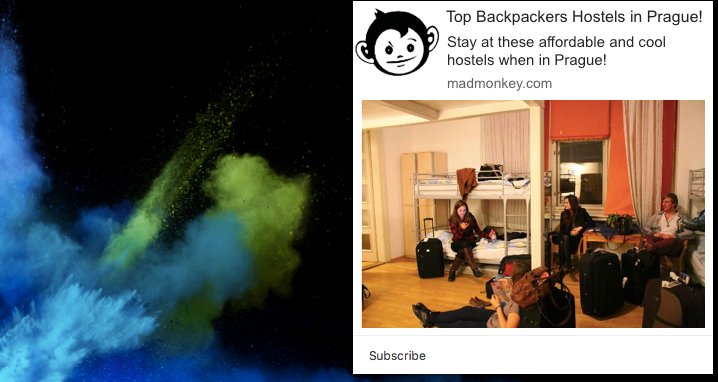
Download Free: Push Notifications Guide
3) Enabling good user experience is hard work. But not that hard.
One of the reasons why marketers turn to push notifications is that it is one of the simplest and easiest to use communication channels. Just craft a Title and Copy and hit send. However, push notifications also come with two sets of features that lend distinct capabilities to the medium.
The first set enables marketers to send richer push notifications. It includes features like Big Images and CTA Buttons.
The second set of features make your push notifications more intelligent and intuitive when it comes to understanding what your subscriber needs. Audience Segmentation belongs to this category. It shares this space with other features like Triggered Campaigns and Push Notification Scheduling.
Using this set of features needs a bit of setting up from your side, like defining your segments, for instance. However, creating a segment is a fairly simple task to perform on your dashboard. Once you set it up, you can forget about it. It does its job while helping you give a better user experience to your subscribers.

4) Segmentation is the first step towards personalization
According to research, 40% of retailers said that personalization is a top digital priority. This brings us back to where we started. Your subscribers behave differently from each other and they are different from each other.
If you are a news website, you might have a chunk of audience who consumes only sports updates. You wouldn’t want to send them breaking news they are not interested in. Segmentation helps you achieve that.
If you break it down further, you might have a bunch of subscribers who follow only Soccer-related news. You wouldn’t want to send them updates about Hockey. Audience Segmentation helps you achieve this level of granularity and take the first step towards meaningful personalization.
If you’re convinced about the importance Audience segmentation, you can sign up for a free trial and start using VWO Engage’s Segment Creator, right here. If you found what you just read useful, and would like to stay updated on more such pieces, then do subscribe to our blog, The Marketer’s Last Mile.
]]>How would you derive valuable insights from the results of A/B testing? And more importantly, how would you incorporate those insights into subsequent tests?
Acquiring information is perhaps the easier part of a data analysis program. Drawing insights from that information and converting those insights into actions is what leads to successful results.
Download Free: A/B Testing Guide
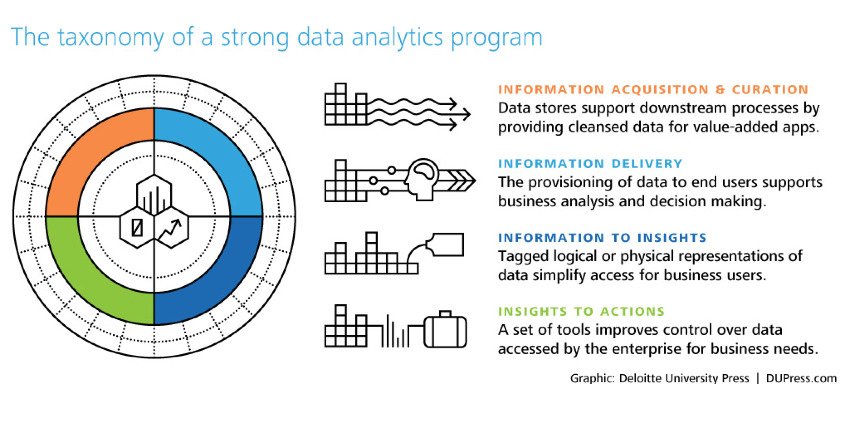
This post talks about why and how you should derive insights from your A/B test results and eventually apply them to your conversion rate optimization (CRO) plan.
Analyzing your A/B test results
No matter how the overall result of your A/B test turned out to be — positive, negative, or inconclusive — it is imperative to delve deeper and gather insights. Not only can this help you to aptly measure the success (or failure) of your A/B test, but can also provide you with validations specific to your users.

As Bryan Clayton, CEO of GreenPal puts it, “It amazes me how many organizations conflate the value of A/B testing. They often fail to understand that the value of testing is to get not just a lift but more of learning.
Sure a 5% to 10% lift in conversion is great; however, you are also trying to find out what makes your customers say ‘yes’ to your offer.
Only with A/B testing can you close the gap between customer logic and company logic and, gradually, over time, match the internal thought process that is going on in your customers’ heads when they are considering your offer on your landing page or within your app.”
Here is what you need to keep in mind while analyzing your A/B test results:
Tracking the right metric(s)
When you are analyzing A/B test results, check if you are looking for the correct metric. If multiple metrics (secondary metrics along with the primary) are involved, you need to analyze all of them individually.
Ideally, you should track both micro and macro conversions.

Brandon Seymour, founder of Beymour Consulting rightly points out: “It’s important to never rely on just one metric or data source. When we focus on only one metric at a time, we miss out on the bigger picture. Most A/B tests are designed to improve conversions. But what about other business impacts such as SEO?
It’s critical to make an inventory of all the metrics that matter to your business, before and after every test that you run. In the case of SEO, it may require you to wait for several months before the impacts surface. The same goes for data sources. Reporting and analytics platforms aren’t accurate 100 percent of the time, so it helps to use different tools to measure the performance and engagement. It’s easier to isolate reporting inaccuracies and anomalies when you can compare results across different platforms.”
Most A/B testing platforms have built-in analytics sections to track all the relevant metrics. Moreover, you can also integrate these testing platforms with the most popular website analytics tools such as Google Analytics. Integrating VWO with a third-party tool is simple and allows you to push your VWO test data into the external tool. It also allows the data made available by these tools on the website to target campaigns.VWO offers seamless integration with popular analytics tools as well as plugins for content management systems which makes it very easy to install the VWO code and start optimizing your website.

Conducting post-test segmentation
You should also perform segmentation of your A/B tests and analyze them separately to get a clearer picture of what is happening. The results you derive from generic nonsegmented testing will provide illusory results that lead to skewed actions.
There are broad types of segmentation that you can create to divide your audience. Here is a set of segmentation approach from Chadwick Martin Bailey:
- Demographic
- Attitudinal
- Geographical
- Preferential
- Behavioral
- Motivational
Post-test segmentation in VWO Testing allows you to deploy variation based on a specific user segment. For instance, if you notice that a particular test affected new and returning users differently (and notably), you will want to apply your variation only to that particular user segment.
However, searching through lots of different types of segments after a test means you are assured of seeing a lot of positive results just because of random chance. To avoid that, make sure you have your goal defined clearly.
Delving deeper into visitor behavior analysis
You should also monitor visitor behavior analysis tools such as Heatmaps, Scrollmaps, Visitor Recordings and so on to gather further insights into A/B test results. For example, consider a search bar on an eCommerce website. An A/B test on the navigation bar works only if users actually use it. Visitor recordings can reveal if users are finding the navigation bar friendly and engaging. If the bar itself is complex to understand, all the variations of it can also fail to influence users.
Apart from giving insights on specific pages, visitor recordings can also help you understand user behavior across your entire website (or conversion funnel). You can learn how critical the page on which you are testing is in your conversion funnel.

Download Free: A/B Testing Guide
Maintaining a knowledge repository
After analyzing your A/B tests, it is imperative to document the observations from the tests. This helps you not only in transferring knowledge within the organization but also in using them for reference later.
For instance you are developing a hypothesis for your product page, and want to test the product image size. Using a structured repository, you can easily find similar past tests which could help you understand patterns on that location.
To maintain a good knowledge base of your past tests, you need to structure them appropriately. You can organize past tests and the associated learning in a matrix, differentiated by their “funnel stage” (ToFu, M,oFu or BoFu) and “the elements that were tested.” You can add other customized factors as well to enhance the repository.

Look at how Sarah Hodges, co-founder of Intelligent.ly, maintains track of the A/B test results, “At a previous company, I tracked tests in a spreadsheet on a shared drive that anyone across the organization could access. The document included fields for:
- Start and end dates
- Hypotheses
- Success metrics
- Confidence level
- Key takeaways
Each campaign row was also linked to a PDF with a full summary of the test hypotheses, campaign creative, and results. This included a high-level overview, as well as detailed charts, graphs, and findings.
At the time of deployment, I sent out a launch email to key stakeholders with a summary of the campaign hypothesis and test details and attached the PDF. I followed up with a results summary email at the conclusion of each campaign.
Per my experience, concise email summaries were well-received; few users ever took a deep dive into the more comprehensive document.
Earlier, I created PowerPoint decks for each campaign I deployed, but ultimately found that this was time-consuming and impeded the agility of our testing program.”
Applying the learning to your next A/B test
After you have analyzed the tests and documented them according to a predefined theme, make sure that you visit the knowledge repository before conducting any new test.
The results from past tests shed light on user behavior on a website. With a better understanding of the user behavior, your CRO team can have a better idea about building hypotheses. This can help the team create on-page surveys that are contextual to a particular set of site visitors.
Moreover, results from past tests can help your team come up with new hypotheses quickly. The team can identify the areas where the win from a past A/B test can be duplicated. Also, the team can look at failed tests, know the reason for their failure and steer clear of repeating mistakes.
Conclusion
A/B testing is in itself a challenging endeavour. To derive actionable insights from it is a whole different ball game. How do you analyze your A/B test results? Do you base your new test hypothesis on past learning? Data driven decision making has to be at the heart of your experimentation projects. VWO SmartStats frees you from dealing with complexity of statistics and enables you to take quick and intuitive business decisions.
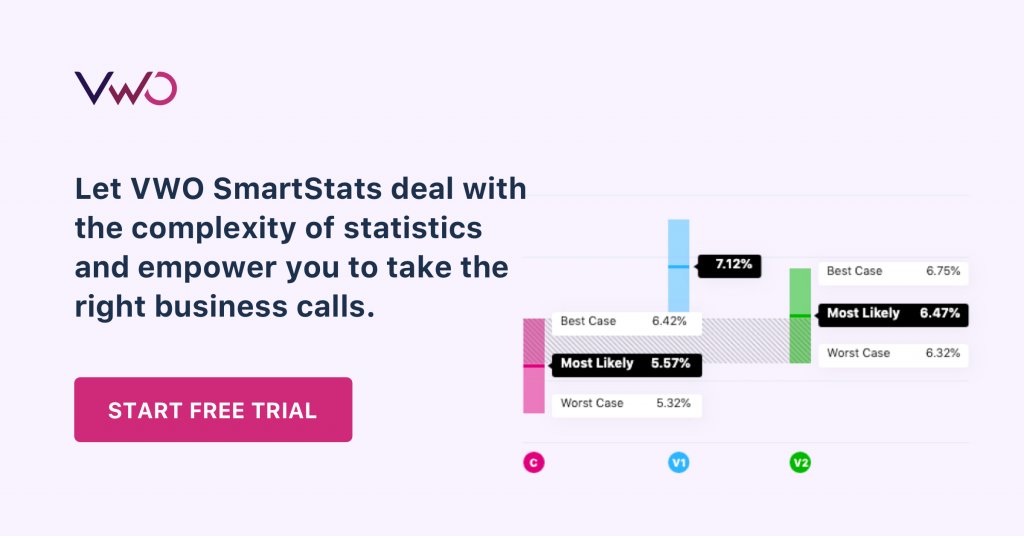
Nobody likes when these pop-ups sprout, blend, and bloom in from all sides while they are attentively reading or watching content.
However, pop-ups have been around for ages, and there’s a reason why they still exist.
They work!
Pop-ups help websites catch the attention of their visitors and convert them into customers or leads, using lucrative offers.
Download Free: Customer Engagement Guide
Exit intent pop-ups, especially, have become increasingly popular in recent years. It’s because they not only deliver conversions for websites, but are also less annoying than traditional pop-ups.
Exit intent pop-ups are displayed to visitors only when they try to leave a website. The pop-ups, typically, offer something of value to visitors (e.g., product discount coupon, free product demo, etc.) that aims to keep them from leaving the website.
Here is an example:
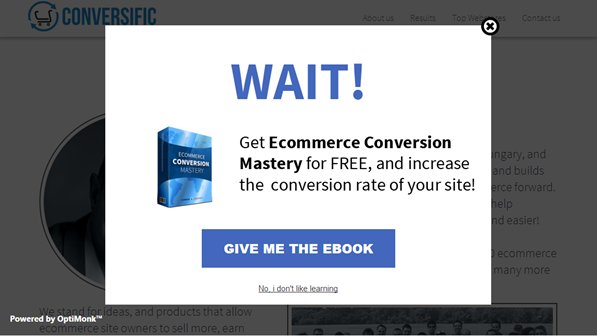
Still, just setting up an exit intent pop-up won’t guarantee you conversions (and it might even hamper the user experience). Therefore, you need to optimize your pop-ups for your website and the visitors, appropriately.
This post will walk you through 6 important factors that determine the effectiveness of exit intent pop-ups.
Note: All “pop-ups” mentioned in this post from here-on refer to “exit intent pop-ups.”
1) Target the Right Visitors
All your website visitors aren’t the same.
Some visitors might be on your website just out of curiosity, some might be there for doing comparison shopping, and only some will become your customers.
Primarily, you must pursue those visitors who have shown at least some intent to become a customer. Next, you should engage more with the new visitors of your website, and lead them down your conversion funnel.
To do that efficiently, you’ll need to segment your website visitors, and target them differently.
Firstly, capture those visitors who have a higher chance of converting. For instance, if you want to acquire subscribers to your blog through pop-ups, target visitors that have visited multiple pages and spent a good amount of time on your blog. For eCommerce sites, it makes more sense to provide attractive offers to those visitors who are abandoning the products in their cart.
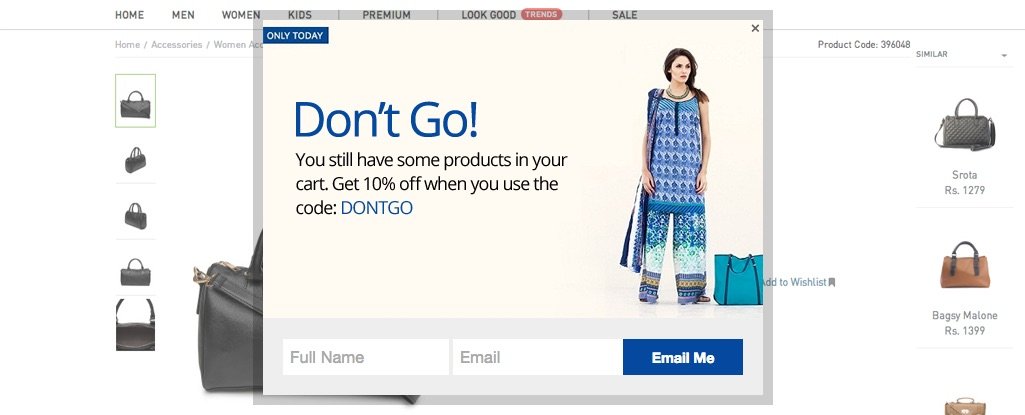
You can target visitors based on their location. This will help you get leads and customers from specific geographies that are tactically important for your business.
You can also target visitors who have actually read the content on your web pages. You can do that by tracking how far they’ve scrolled down a page and how much time they’ve spent on it. For instance, you can set pop-ups for only those visitors who’ve scrolled down more than 70% and spent more than 90 seconds on a webpage. This is especially useful for content based web pages, such as blogs and other reading material focused pages.
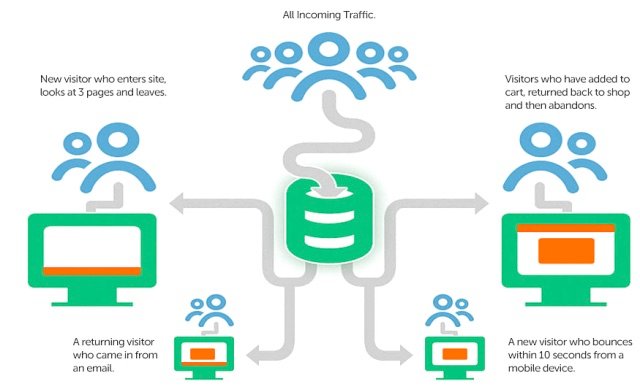
Moreover, you have to be particular about the visitors whom you don’t want the pop-ups to be displayed to. For example, you need to ensure that users who’ve closed the pop-up once do not see it again. Similarly, you shouldn’t display pop-ups with a subscription form to visitors who’ve already signed up.
2) Employ Contextual Offers
Your pop-ups — no matter how targeted — can still ruin the user experience on your website if they aren’t contextual.
Your pop-ups must relate to visitors’ activity in each of their user sessions. In other words, they need to be in line with the web page visitors are on.
Suppose, you have a fashion eCommerce website catering to both men and women. On pages that feature men’s products, setting up a pop-up that offers a sale on women’s products will, obviously, not be effective. However, if the pop-up offers a discount on the same product that a visitor is abandoning (exiting the product page), the chance of the visitor staying back and making a purchase is much greater.
Similarly for SaaS websites, it would make sense to offer discounts for visitors that are on the pricing page. In contrast, when visitors are on the features page, your pop-up can offer a resource that demonstrates how your product features are better than the competition.
Take a look at this example:
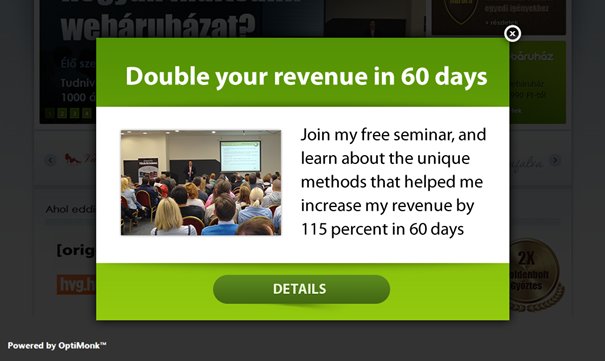
The above pop-up features a “free seminar” to visitors who are on the content-offering pages of the website. We can safely assume that the visitors are interested in the website’s content, and a seminar might interest them further.
Ideally, you should look at your website as a conversion funnel. The web pages that attract the bottom-of-the-funnel visitors should contain pop-ups with high value offerings, such as discount coupons, product comparisons, case study of known brands, etc. Web pages that largely attract top-of-the-funnel visitors can offer a generic freebie (or skip having pop-ups altogether).
3) Write Scannable Copy
The average attention span of web users is less than 9 seconds. The attention given to your exit intent pop-up is even lesser.
When encountering an exit intent pop-up, visitors will only give the pop-up a short glance. (Remember, they are trying to leave the website.)
This makes it vital for the pop-ups to have scannable and snackable content. No visitor is going to go through a pop-up having 1000 words of text.
You need to keep your pop-up copy short and clean. Here’s a great example from WhichTestWon:
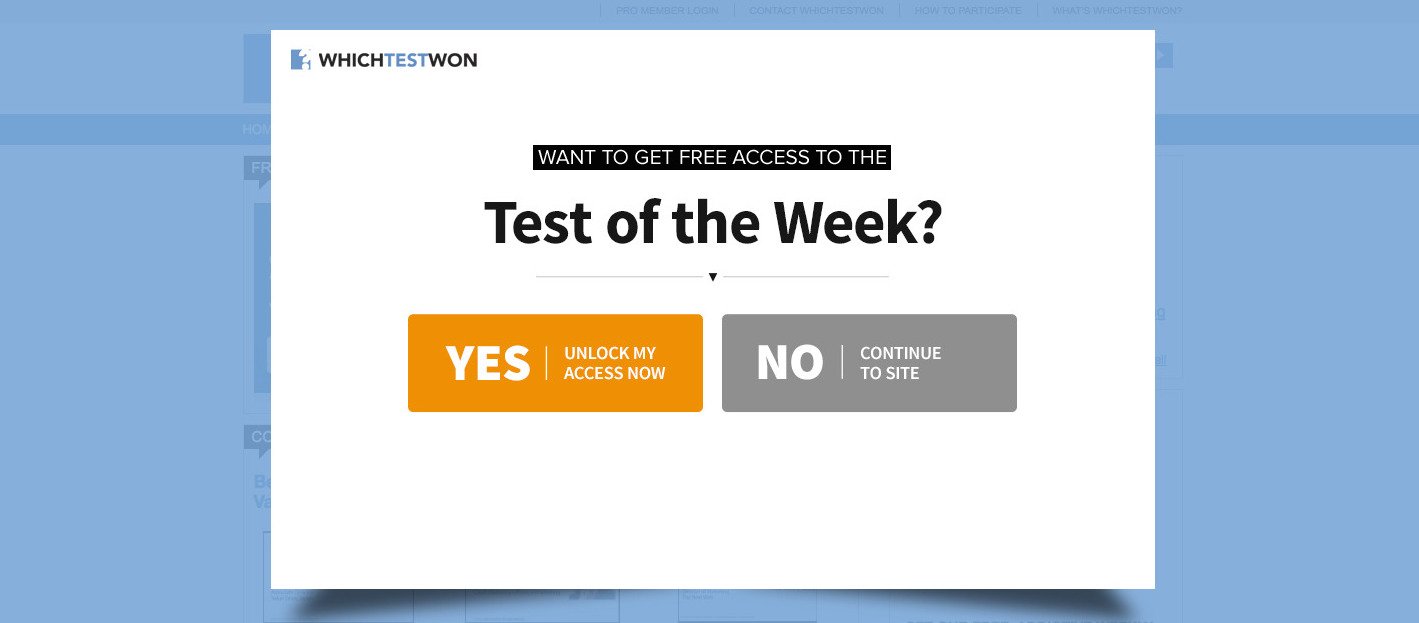
The pop-up features minimal text and attention-grabbing call-to-action, making it easy for visitors to read it instantly. However, it’s important to notice that even with such less content, the pop-up is able to successfully put across value (free access to the “test of the week”) to visitors.
You will also notice that the pop-up does not include any form-field. That is because it hides behind the “Yes” button. It looks like this:
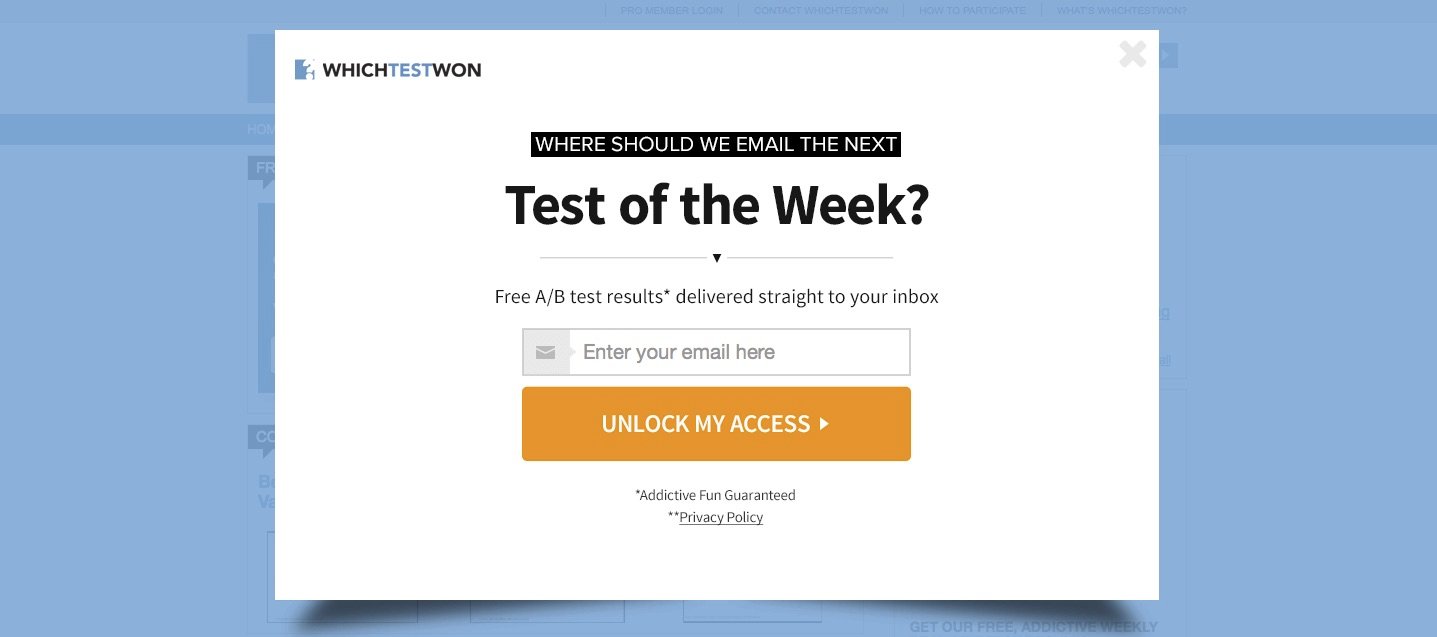
By not showing the form-field upfront, the pop-up reaps a couple of benefits. Firstly, it is able to comfort visitors about the fact that they can proceed with just a click. Secondly, it is able to secure higher form-fill rate as only high-intent visitors (those who’ve clicked on the “Yes – Unlock My Access” button) reach the form.
You can follow WhichTestWon’s cue, and employ multi-step lead gen pop-ups that help you minimize the content. Or, you can go a step further and develop a landing page dedicated for your pop-up.
In order to keep your pop-ups lean, you should also aim to offer self-explanatory resources. Ideally, you shouldn’t spend any text explaining the resource.
Although contextual, a long description of your free resource will repel the visitors’ attention. Remember, your pop-up isn’t a typical lead-gen form and your free resource isn’t a typical lead magnet. For instance, below is a regular lead gen form and this is NOT how your pop-up should end up looking.
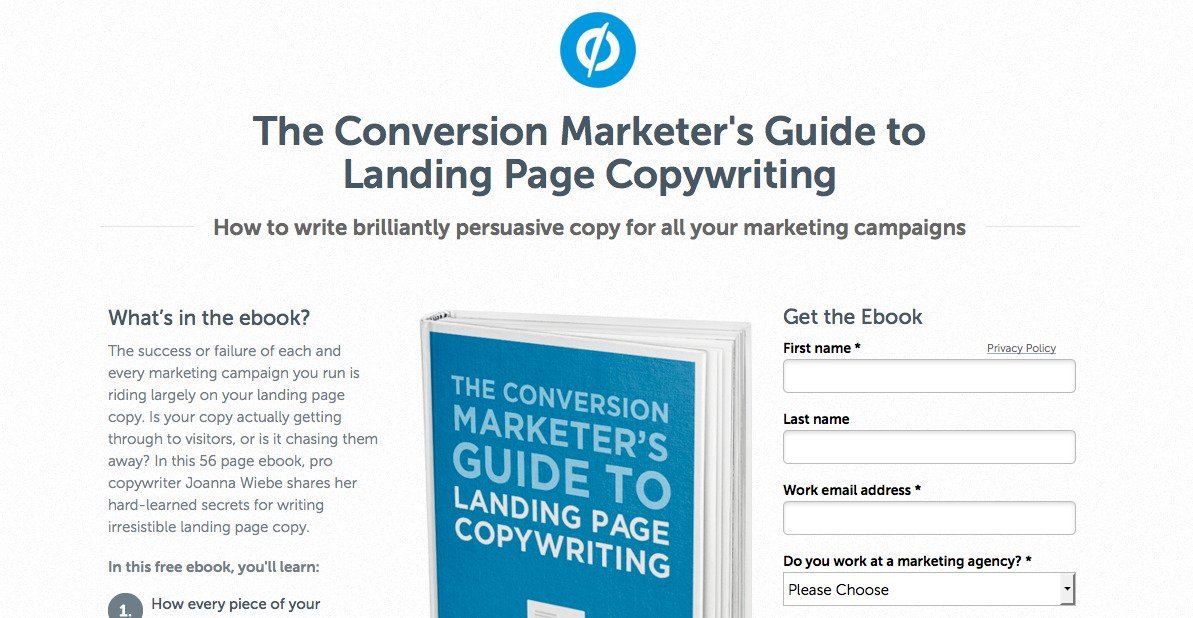
Related Post: 9 Actionable Tips to Build An Effective Lead Magnet
Download Free: Customer Engagement Guide
4) Offer Something Truly Valuable
The most important feature of a pop-up is the offering it contains for visitors. It goes without saying that the offering must have great value in order to impel visitors into taking an action on the pop-up.
Sometimes, it is pretty straightforward. You can put up discount coupons or other offers like free shipping on your pop-ups. Other times, you have to get innovative.
Let’s take an example from XeroShoes. XeroShoes offers barefootwear that can be used for outdoors and recreational activities. Since barefootwear is a fairly novel concept, XeroShoes has to try hard to convince its website visitors. If XeroShoes wants its visitors to convert into customers, it must provide them with solid advantages of barefootwear over regular shoes. And, this is exactly what one of their exit intent pop-ups did. It offered a well-researched, detailed report on the benefits of barefootwear.
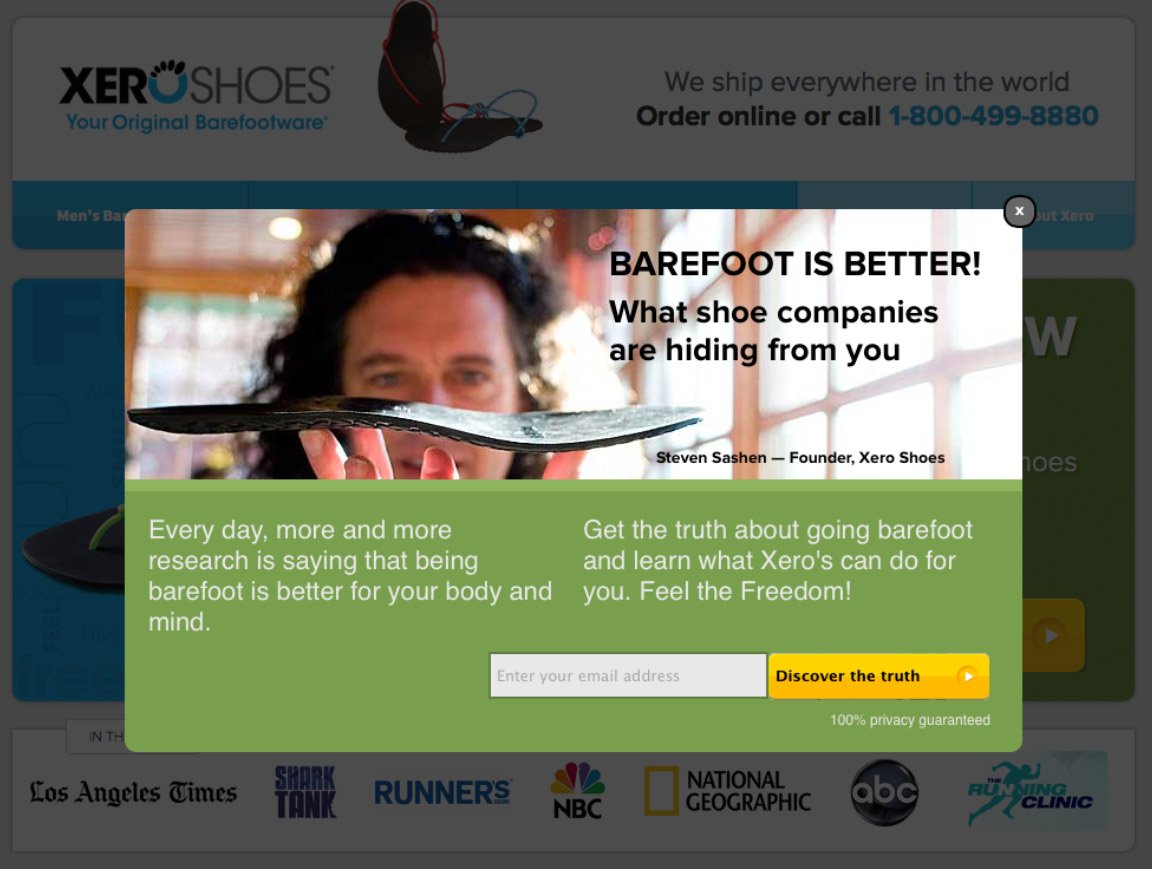
The pop-up made 2.5% of abandoning visitors download the report. And out of those visitors, 28.4% visitors went on to make a purchase.
Another fine example is from Gr8tFires. The website offers gas and wood-burning fireplaces and stoves. Their sales cycle is typically long, which requires educating the customers about various aspects of their products. One such aspect is “installation.” The installation cost is one factor that influences the purchase decision of the visitors.
Keeping that in mind, Gr8tFires offered an “installation cost calculator” to its abandoning visitors.
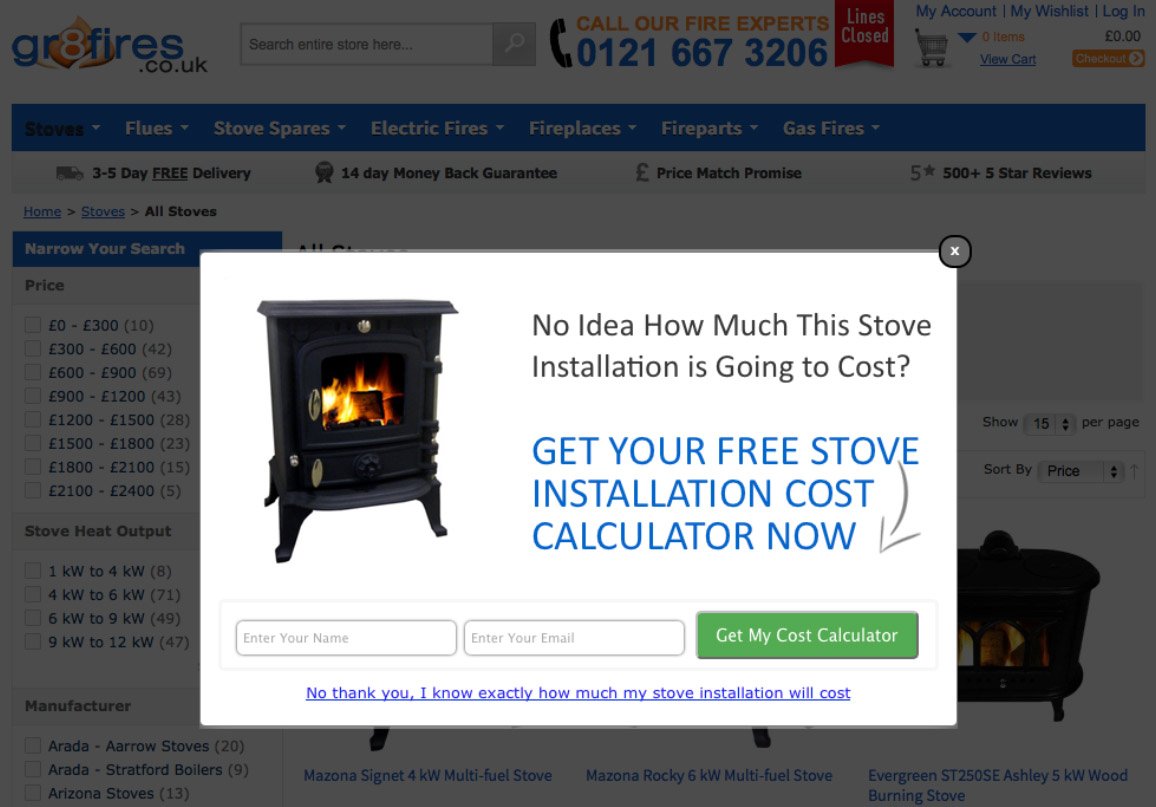
The pop-up caused a 300% increase in Gr8tFires’s sales leads per month.
The offering in the above two pop-ups helped visitors through their purchase decision. This is what your pop-up should aim at, too.
5) Fine Tune Your Call-to-Action (CTA)
The CTA on your pop-up should be clear, and resonate with the action that visitors are expecting on the button click. Look at the CTA from this pop-up by WP Beginners.
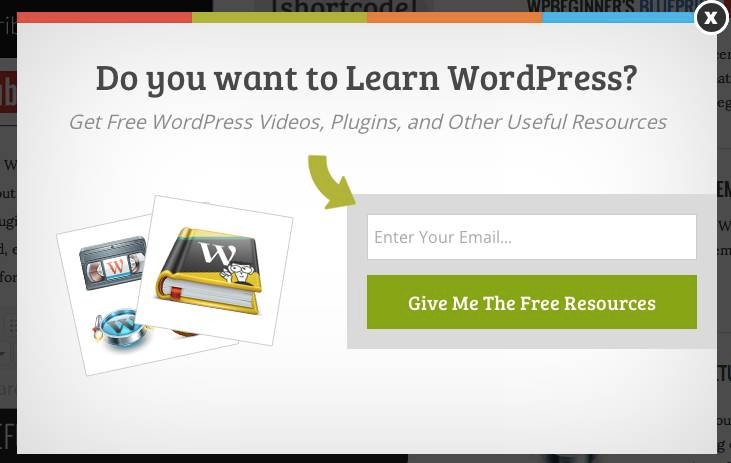
The CTA has a considerably large presence on the pop-up, and displays text that encourages visitors to take an action.
Additionally, you can add a negative CTA alongside the main CTA to make it even more compelling. The negative CTA influence visitors by making them think that they’re missing out on a valuable resource. It employs the psychological factor known as FoMO (or Fear of missing out).
Here’s how Backlinko does it. The negative CTA in the pop-up reads, “I don’t want 25,000 more visitors to my site.” Surely, not many visitors will not want 25,000 extra visitors to their website. And for those who want it, the negative CTA tries to establish a FoMO.
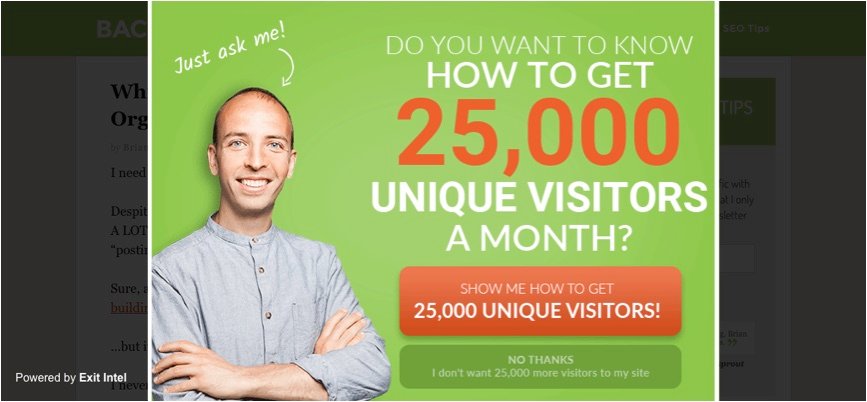
6) Optimize for Mobile
It’s no news that a significant share of internet traffic comes from the mobile medium. Your website, too, might have a good percentage of mobile visitors (you can track that using a website analytics tool).
Considering this, your pop-ups must be optimized for the mobile screen. Ensure that your pop-ups are built on a responsive web design.
Additionally, you should view your pop-ups on a mobile screen to know if the text content and CTA(s) are optimally placed.
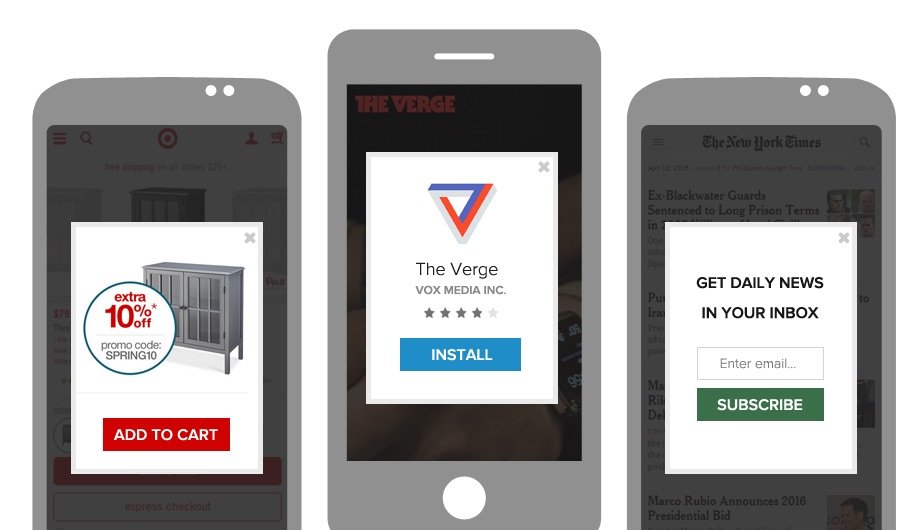
Your mobile pop-ups can prove to be effective if most of your site abandoners use the mobile channel.
Furthermore, you can employ pop-ups that you want to display to your mobile visitors only. For instance, your mobile pop-up can feature your mobile application and ask visitors to download it, when they try to leave your website.
Related Post: A Guide to Using Google Analytics Metrics and Dimensions for Conversion Optimization
Before You Leave
Tell us which optimization technique did you find the most useful? Have your own optimization idea? Write to us at [email protected]!
]]>What do these eCommerce giants have in common? They all command massive brand popularity, have a loyal customer base and have the key analytics working in their favor.
You might not have their level of reach, resources, brand name or market share, but that does not stop you from adopting their ecommerce best practices. In this post, we list 10 things the top eCommerce players are doing brilliantly and how you could follow these practices too.
Download Free: Improve Conversions In 60 Days Guide
The only criterion for choosing these eCommerce names is that all of them fall under the top 1,000 sites according to Alexa. Here are the websites with their rankings.
- Zappos (Rank 698)
- Amazon (Rank 11)
- Target (Rank 324)
- ebay (Rank 21)
- Walmart (Rank 181)
- Nordstrom (Rank 679)
- HomeDepot (Rank 476)
- Dell (Rank 378)
- Ikea (Rank 249)
- OverStock (Rank 781)
Now, here’s what you can learn from them:
1) Zappos – Love your customers
Zappos is the first name that comes to mind when one thinks of customer service. It’s their commitment to ‘Deliver Wow through Service’ that makes them the undisputed customer happiness king in the eCommerce world. There have been numerous stories about their staff members going out of their way to strike an emotional chord with customers. In fact, one of the customer representatives has even set a record of taking a 10-hour call with a customer.
The website encourages customers to talk to the support staff (who have been trained for 7 weeks by the way). On the very top of its homepage, Zappos flashes its customer service number and a Live Chat icon. Apart from that, it has a drop down Help menu that lists the different ways a customer can get in touch with them.
![]()
Besides, it has a no-frills attached return policy. It makes no fuss about any returns and actually makes an attempt to spoil its customers by encouraging them to purchase several products in one go, try them out and return some of them later. Don’t believe me? Here’s proof.
How to do it: You can’t possibly apply all these practices in totality as they come at a cost. But you could totally invest in superior customer executives for starters.
2) Amazon – A personalized website for each visitor
Well it’s hard to pick a single brilliant practice when the player you are talking about is the big shark of the eCommerce universe — Amazon. But after much deliberation, I went with Amazon’s personalization strategy.
Each user sees a different variation of the website depending on his/her browsing history. For example, I get to see books related to my browsing history under four different heads on the homepage.
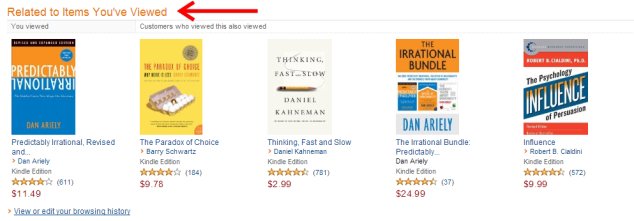
How to do it: There are different tools available to personalize your eCommerce site.
CommerceStack has a free Magento extension called Related Products Manager which uses customer data to generate information on related products, cross-selling or up-selling. Loopit goes a step further and enables your visitors to connect with their friends for advice on the product page. Check out this list of tools to personalize your way to awesome customer experience.
3) Target – Persistent shopping cart
It is almost going to be a month since I flirted with the idea of buying a blazer at Target and it’s still there — intact and mine to be taken. I never signed-in, but it’s there in my shopping cart.
![]()
At a time when every eCommerce site is trying super hard to reduce cart abandonment, a persistent shopping cart helps you recover some of the lost revenue.
An abandoned cart doesn’t always mean a lost sale. It could simply mean the visitor has gone off to another website to compare prices, is sleeping over the purchase, is just too busy to fill up that registration form right now or is on a dreamy wish-listing spree. This means the visitor could very well come back to complete the purchase. And how wonderful would it be if they found their cart exactly in the same order!
A ScanAlert study tells us that 28% of shoppers take longer than a day to convert. There’s another SeeWhy report which states that less than 1% of buyers will convert on their first visit.
How to do it: You can drop a long-term cookie for a particular browser/device combination to ensure the contents of the cart remain intact for a set number of days. Magento, on the other hand, has an in-built persistent cart feature.
4) ebay – Use Geo-targeting to deliver the right message
Geo-targeting essentially means delivering specific messages to users based on their IP location.
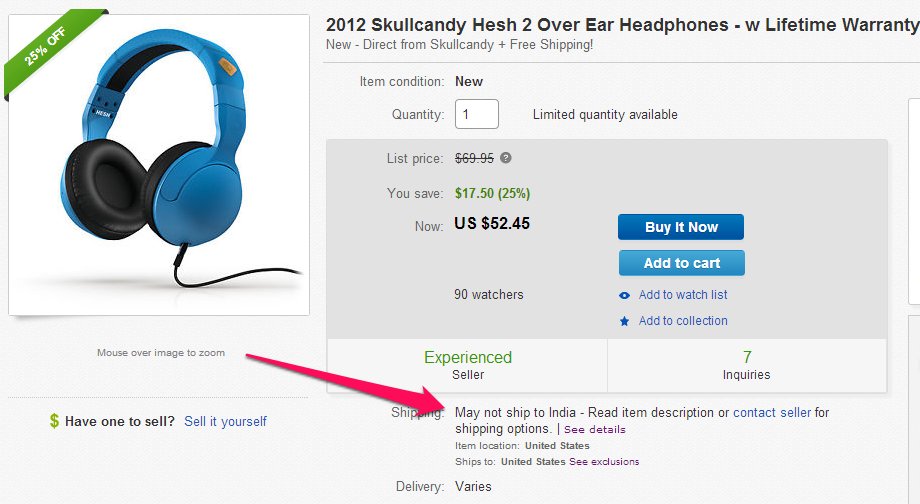
As you can see above that I was checking out a particular pair of headphone on ebay and was told that the item may not be shipped to India. That’s some smart use of geo-targeting. ebay clearly saves its customers a lot of potential heartache there.
How to do it: There are many GeoIP databases available which can be easily integrated in a web application. Maxmind has free and paid versions. There’s also GeoBytes, Neustar, IPligence, Tamo Soft, among others. Some of these databases are free but their accuracy may vary.
But if you are a VWO user, you don’t need to buy any database as you can automatically segment your visitors on the basis of location. In short, you rock!
5) Walmart – Highlight value of the day
Displaying a new offer or deal every day adds a fresh element to the homepage. It both arouses and feeds the curiosity of the users. Once you have got the users hooked, it becomes a habit for them to check out the day’s deal.
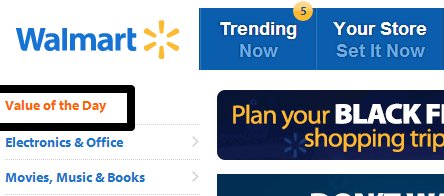
Here, Walmart has ‘Value of the day’ as the first option on its vertical left-hand side navigation bar.
How to do it: Simple coding dear. This won’t require any extra resources. But just don’t jump into it. Offering one new deal every day is a real commitment and you better walk the talk.
Download Free: Improve Conversions In 60 Days Guide
6) Nordstrom – Personalized services
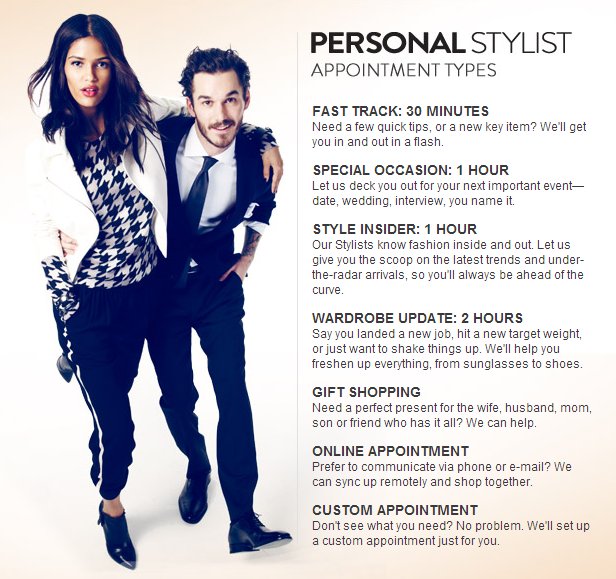
Nordstrom has taken personalized service to a whole new level. Their stylists offer free fashion advice — ranging from helping a customer choose that perfect party dress to completely revamping their wardrobe.
A shopper can book an appointment – with duration ranging from 30 minutes to 2 hours — without any suggested pressure to buy the product later. Now this is a giant leap when it comes to customized service. I am not sure how viable is this strategy, but it definitely ensures a great customer experience.
How to do it: You would want to adopt this strategy only if you categorically offer premium fashion clothing. You will have to invest in a few stylists (depending upon the volume of your business) and a couple of customer care executives.
7) Home Depot – Give detailed shipping info
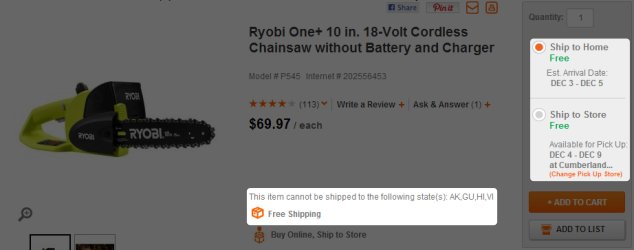
HomeDepot offers comprehensive shipping information. Even before a user puts a particular product in the cart, it tells him whether the order qualifies for free shipping, the estimated arrival date and information about where all the product can’t be shipped.
Telling upfront if the order qualifies for free shipping helps control abandonment rate as ‘being presented with unexpected costs’ is the primary reason for cart abandonment. Giving an estimated arrival date makes sure the customer is better prepared to collect the order.
How to do it: Choose a logistics provider which gives you information about time taken to deliver at different zip codes. If you sign up with UPS to take care of your eCommerce logistics needs, then they’ll provide you an interface for this.
For example, following is UPS’ regular delivery schedule for Belgium.

8) Dell – Break analysis paralysis
‘The more the merrier’, goes a popular phrase. But bombarding your customers with more choices might just work against you. This popular jam study tells you how more choices paralyze the mind and how ‘less’ works better.

Dell does the good deed of breaking the choice paralysis of potential customers by displaying its best-selling PC Deals upfront.
How to do it: This is going to depend on the design of your website. But you don’t necessarily need to go the Dell way, A/B test the placement of your best-selling deals.
9) IKEA – Entice with images

I don’t know what this photo did to you but I just felt a little sorry for myself for not having grown up in a room like this. This is what beautiful images do to potential customers. They entice, spell-bound, fascinate or trigger an endorphin-rush (depending on how much gratification they get out of shopping).
Remember that your customers can’t touch, feel or smell the product. Displaying the product in all its glory is your best bet. One of our customers, Hyundai Netherlands, also found this out when it used VWO to run a multivariate test. Using larger products increased requests for test-drives by 62%.
How to do it: Darn simple. Put a freelance product photographer on the job. Test different images and make sure your website can carry the load of heavy photos.
10) Overstock – Ever present search and navigation bar
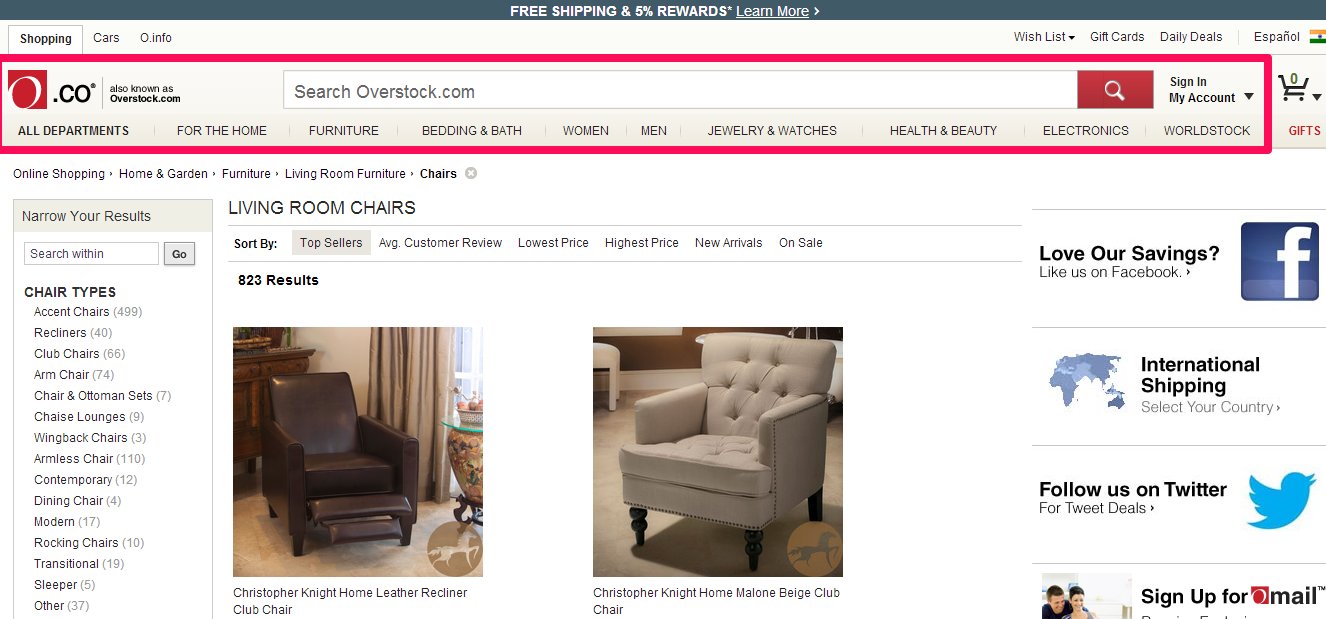
Overstock’s category page scrolled all the way up

The search and navigation bars remain fixed on the top even as we scroll down the page
Search and menu bars are the primary navigation elements on any eCommerce website. Don’t give the customer the trouble of even scrolling up to find that search box. Make the search and navigation bars a consistent feature of the page. When nothing makes sense, they will always know where to go to find their way around the website. Offset that high bounce rate. And here is how to do it: CSS fixed position.
Your top 10
Do you think a particular website deserves to be here?
Let us know your thoughts at [email protected]